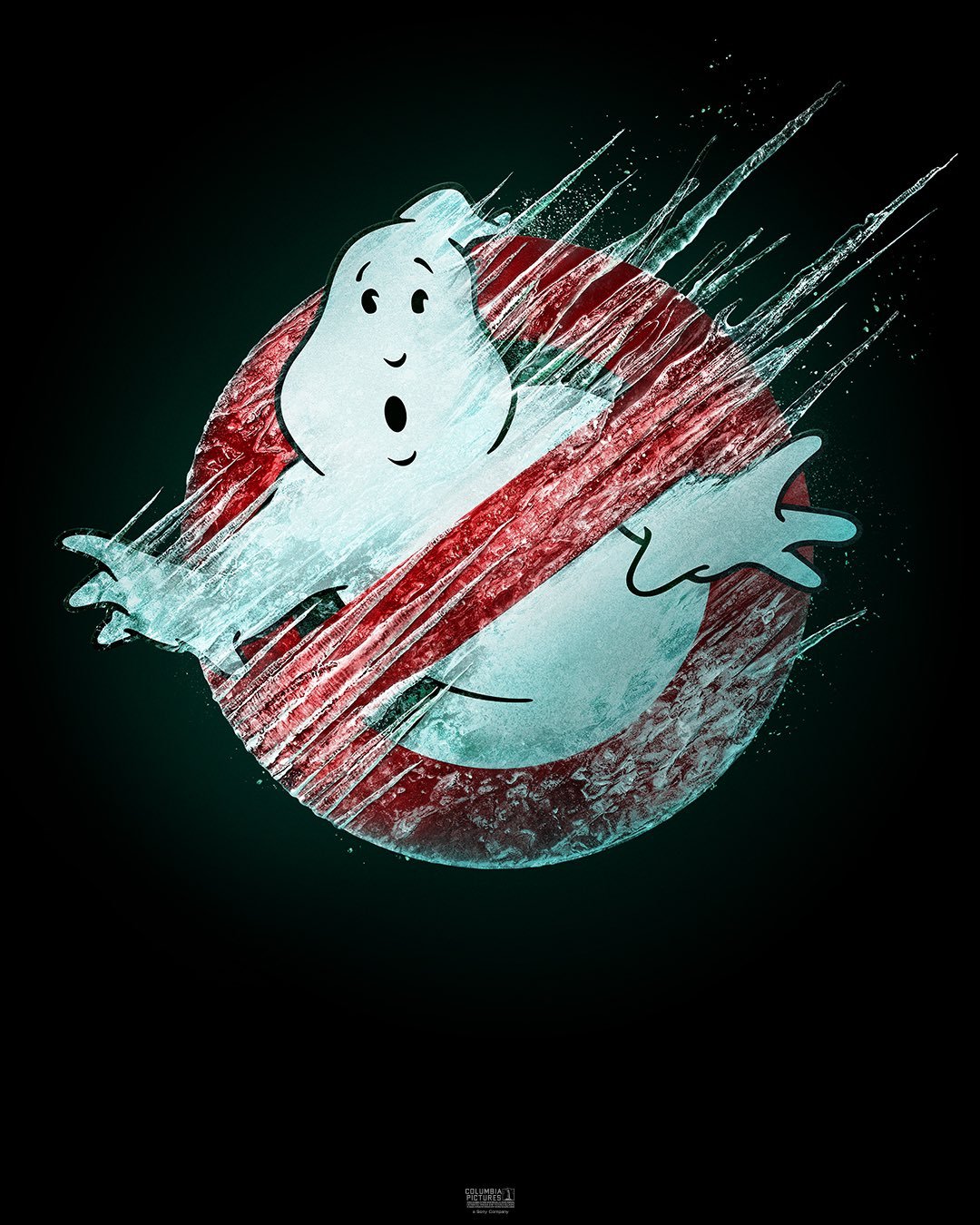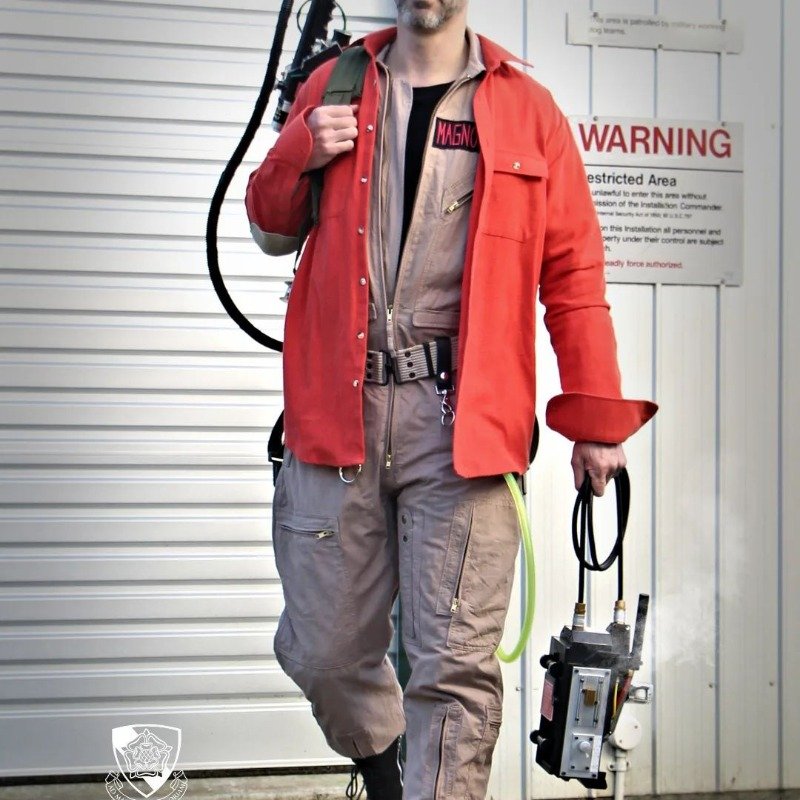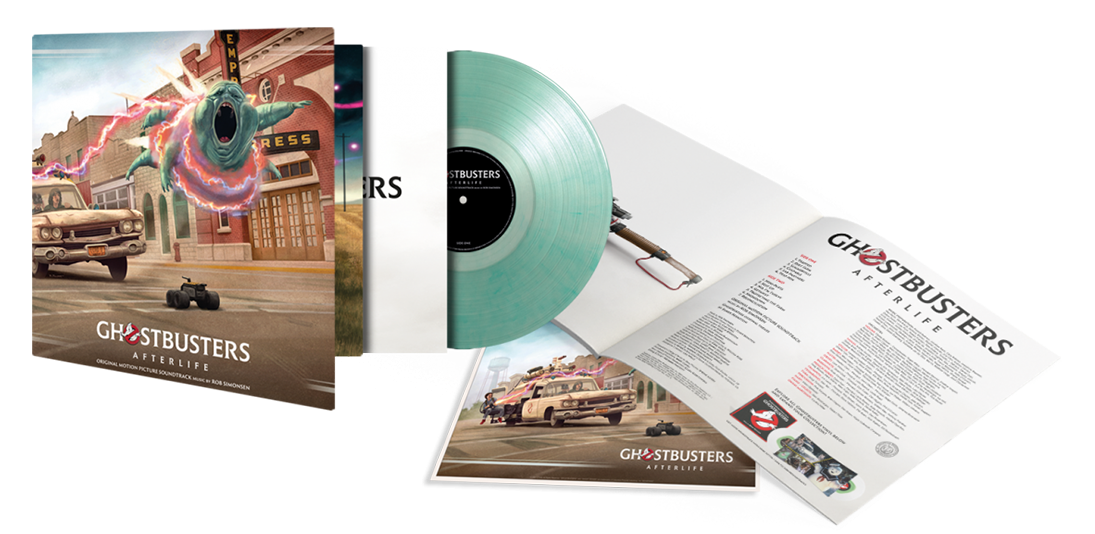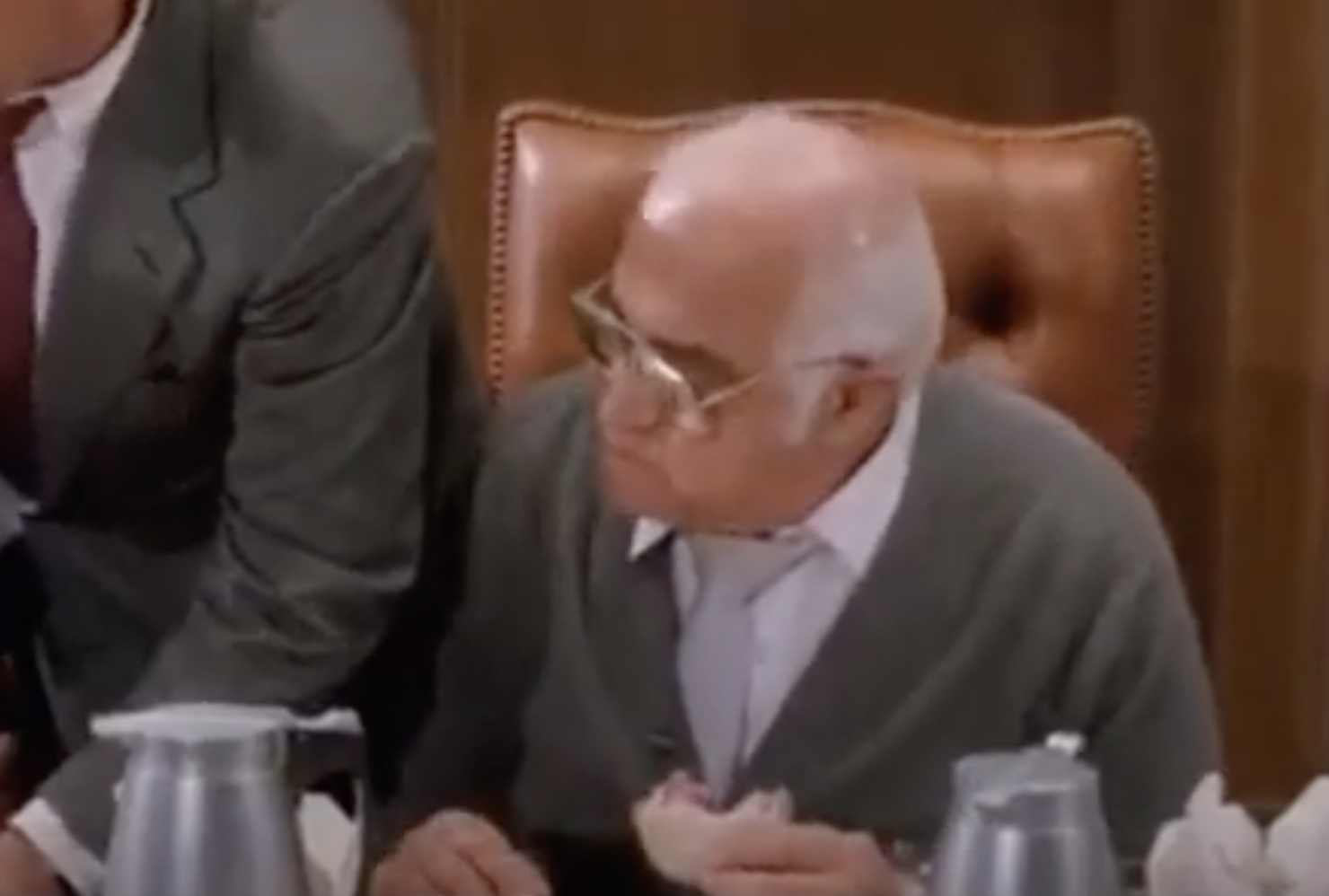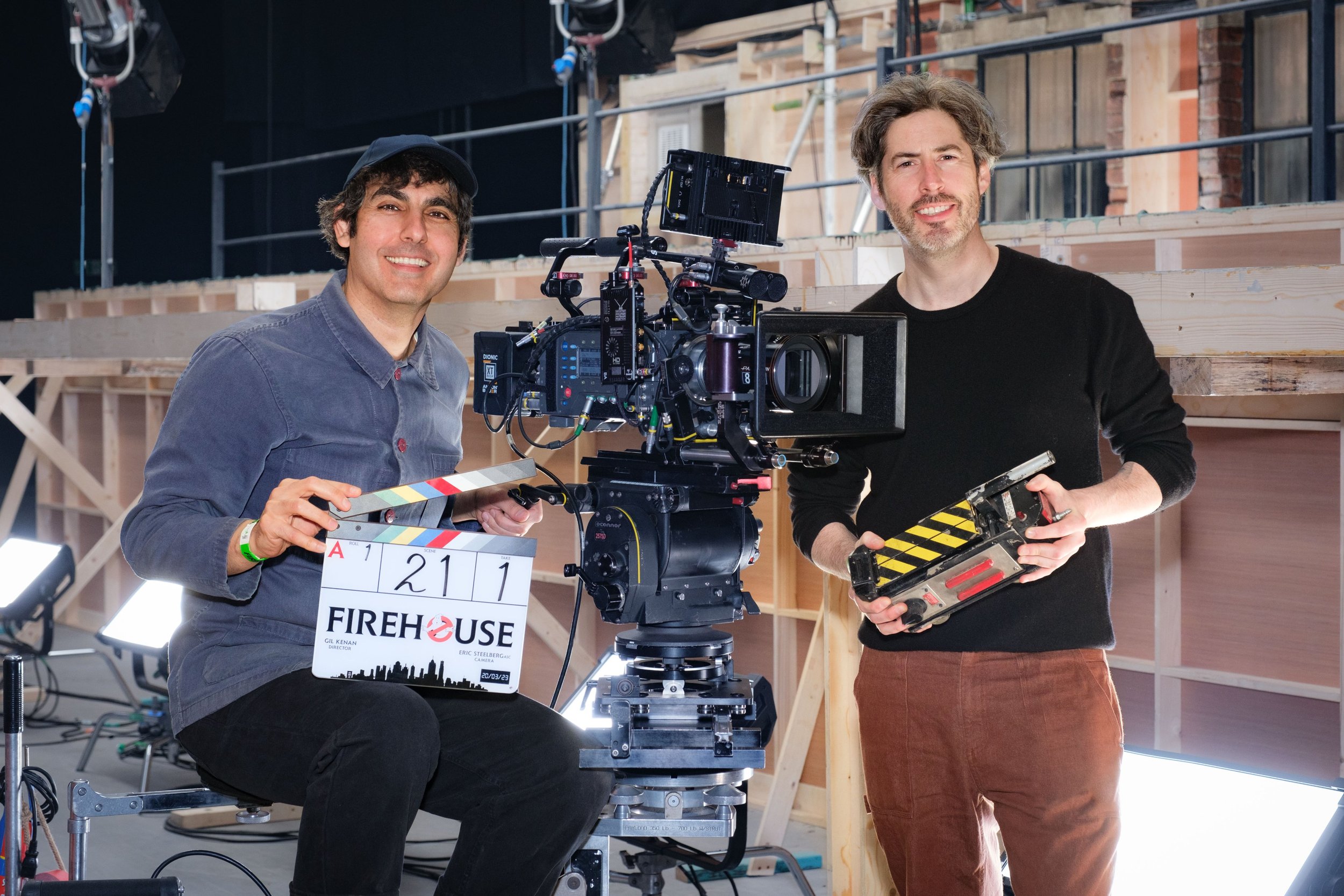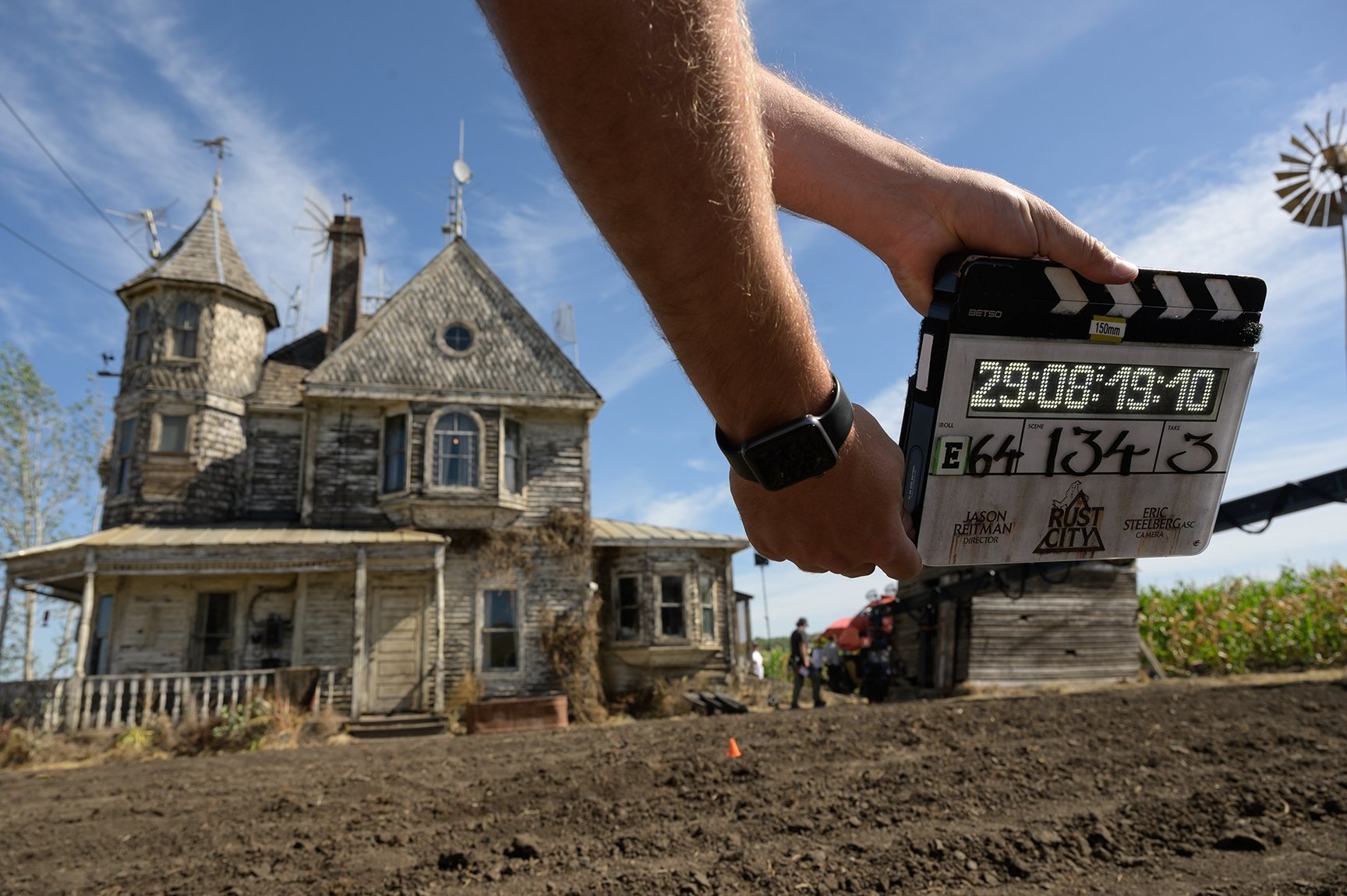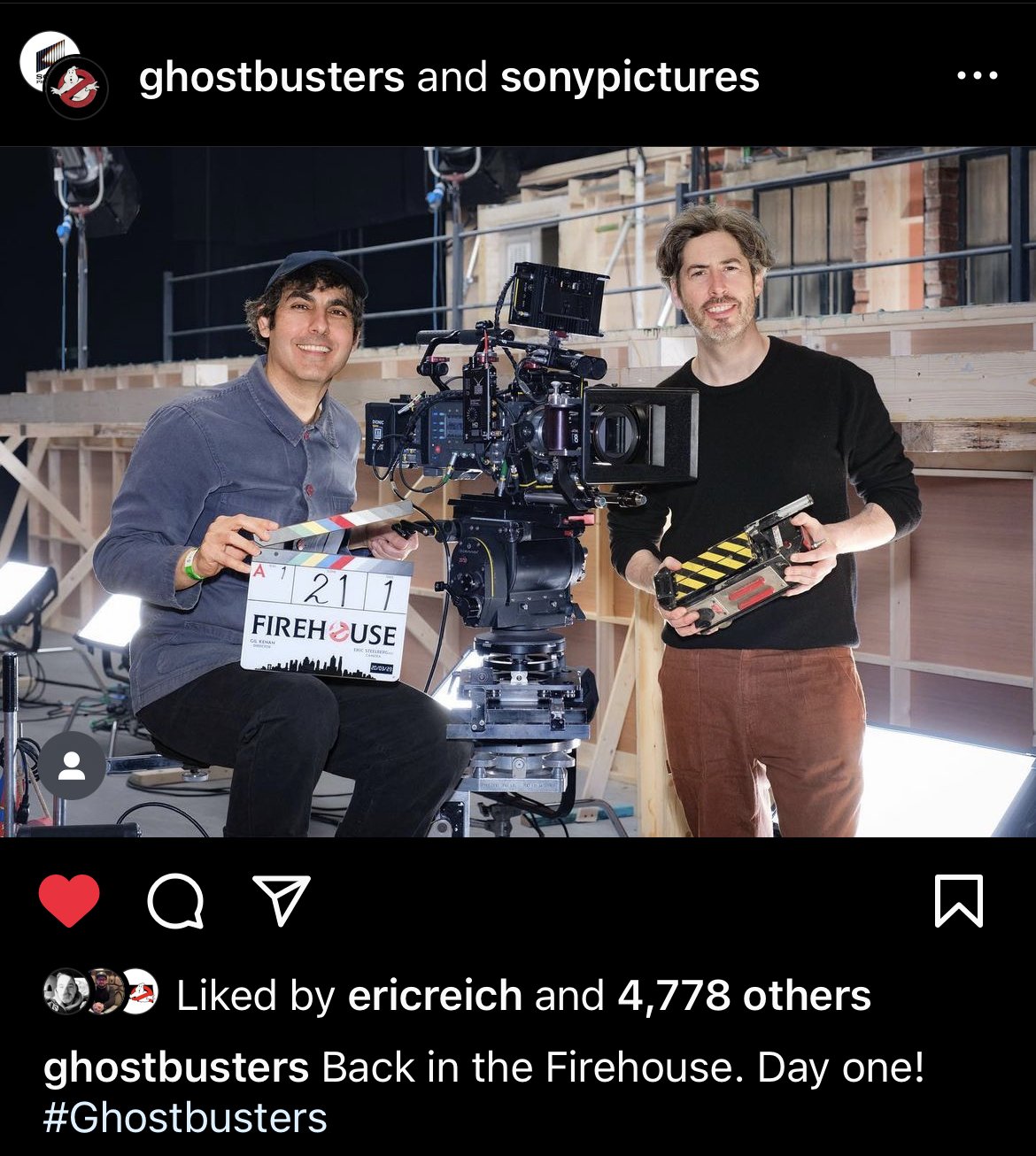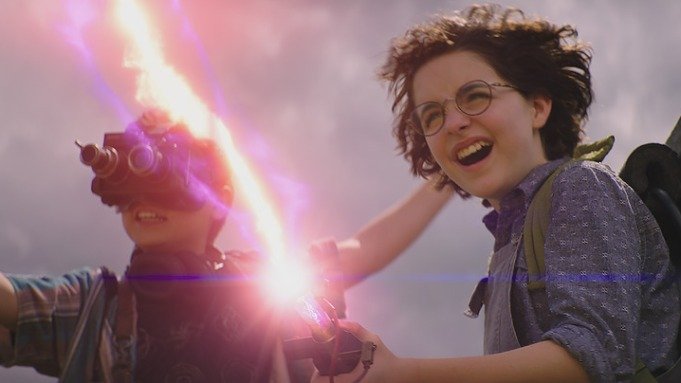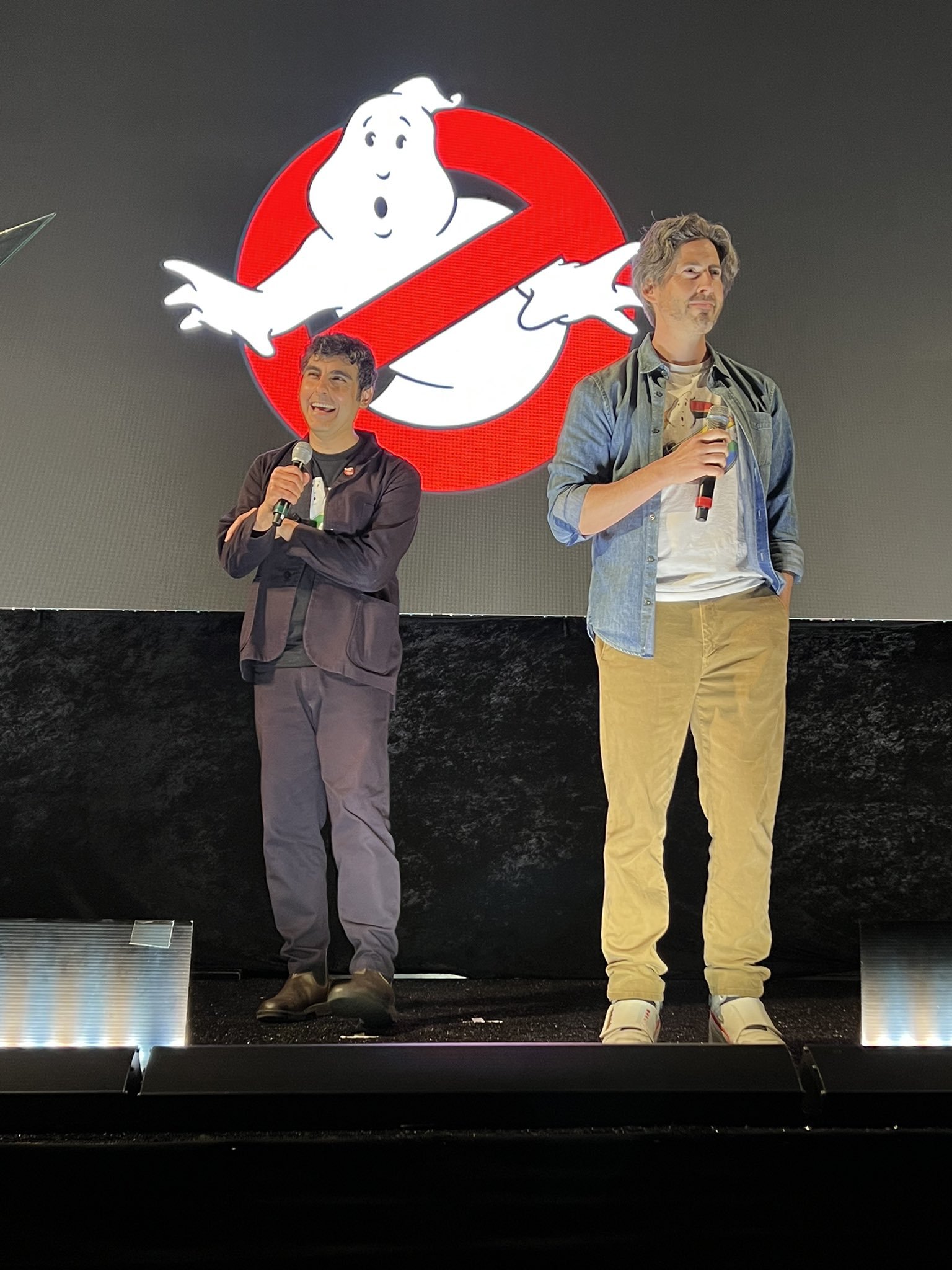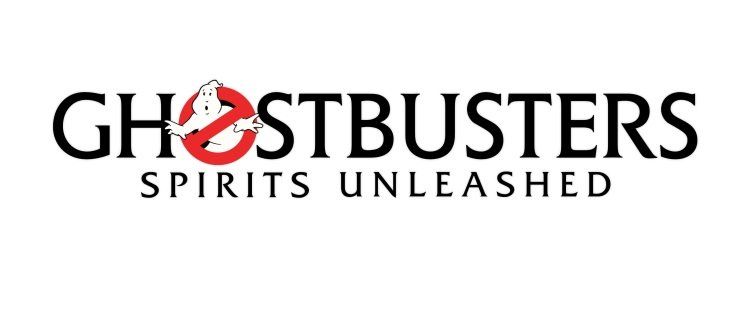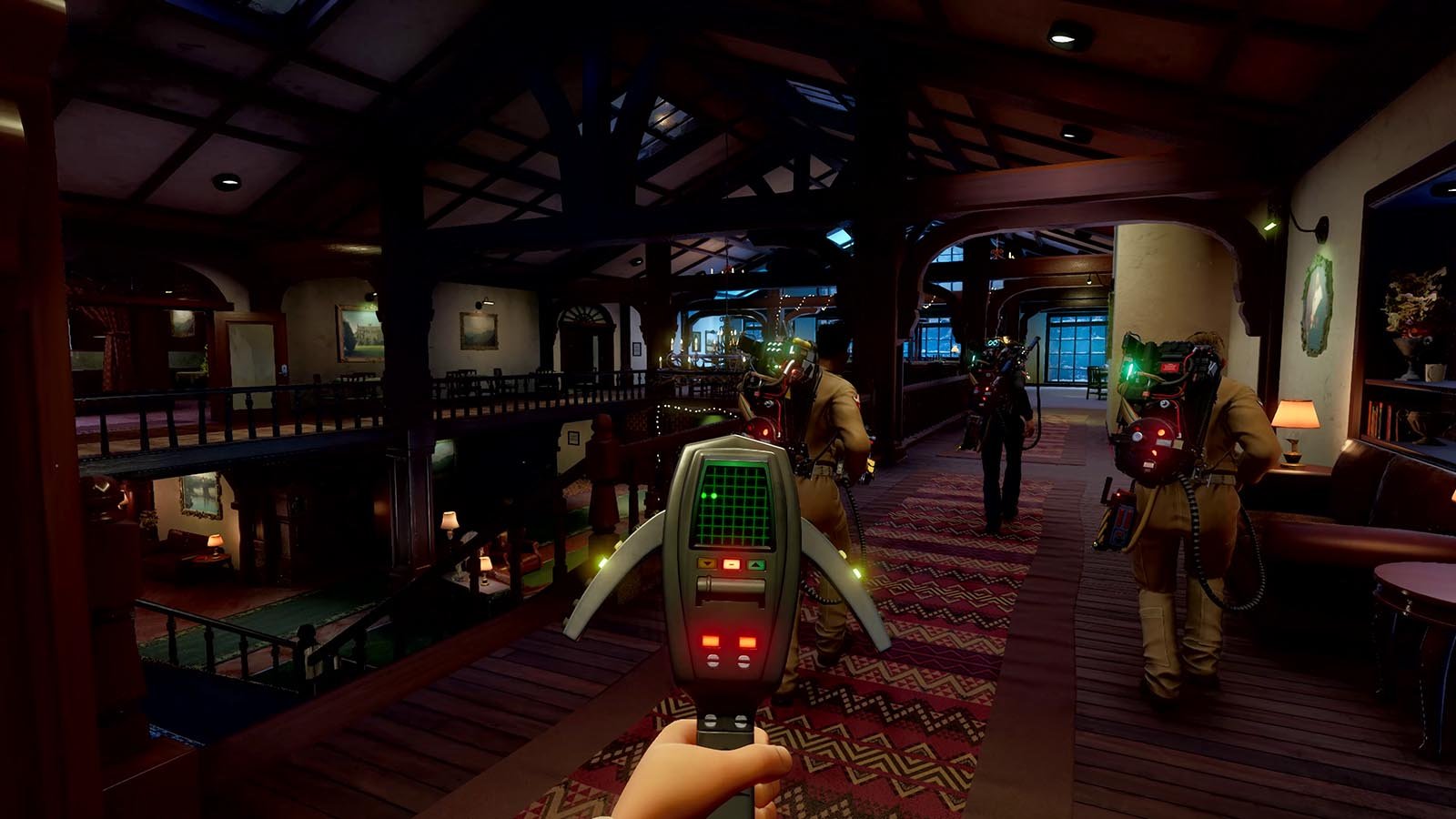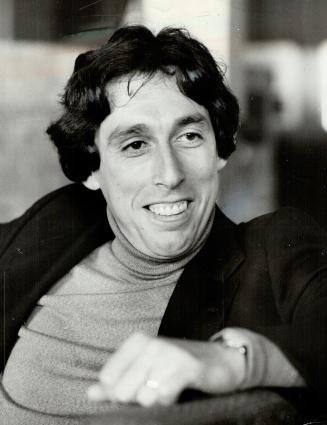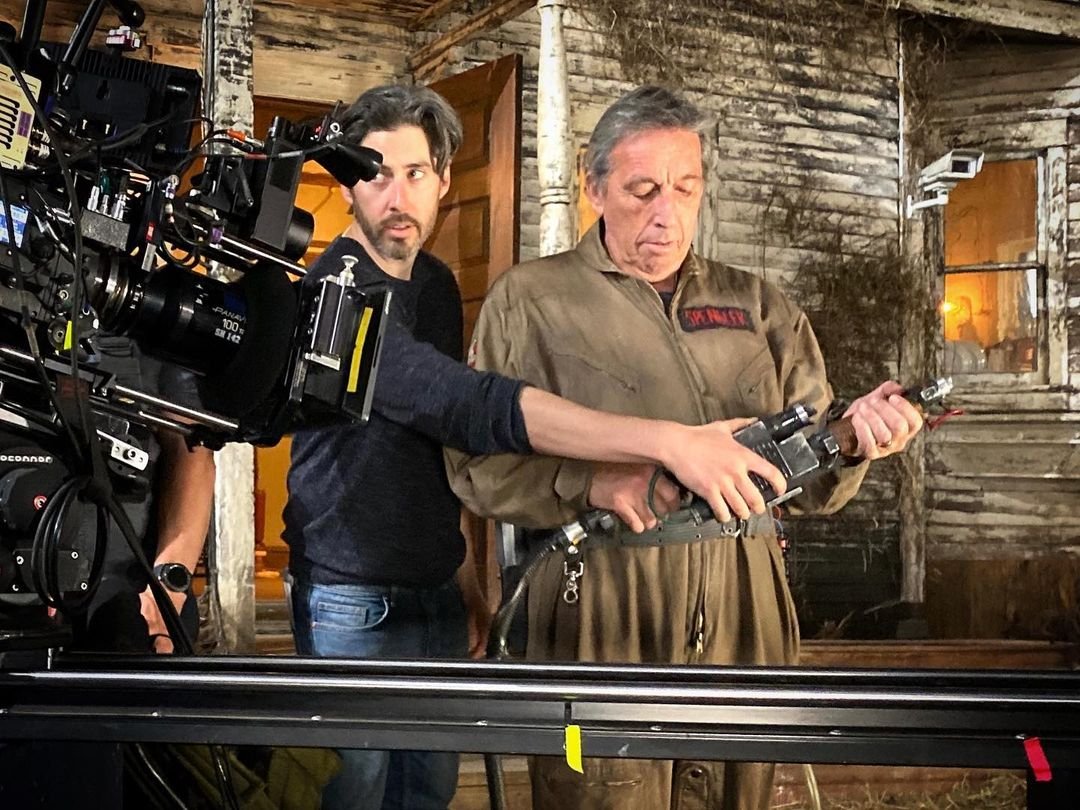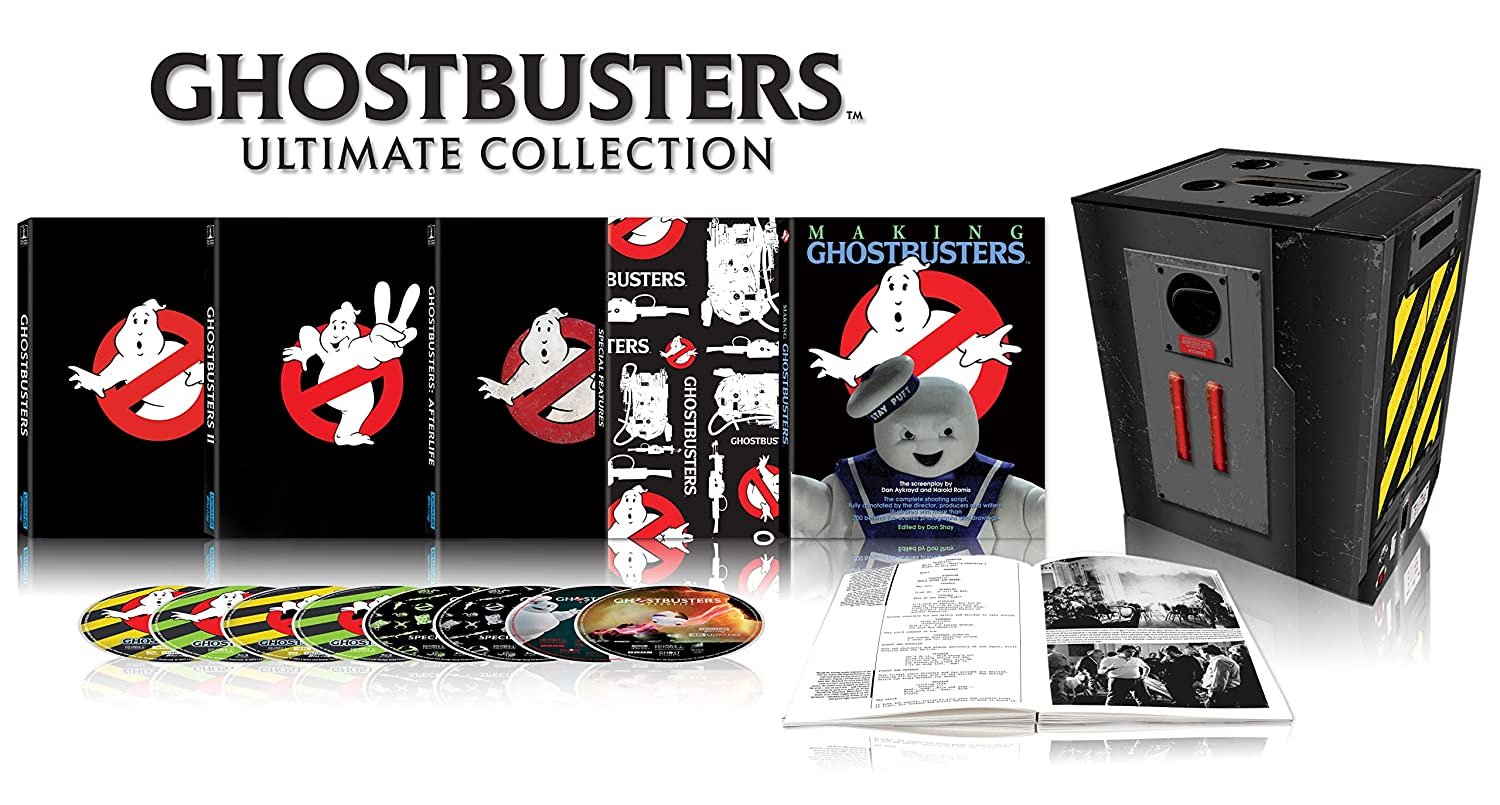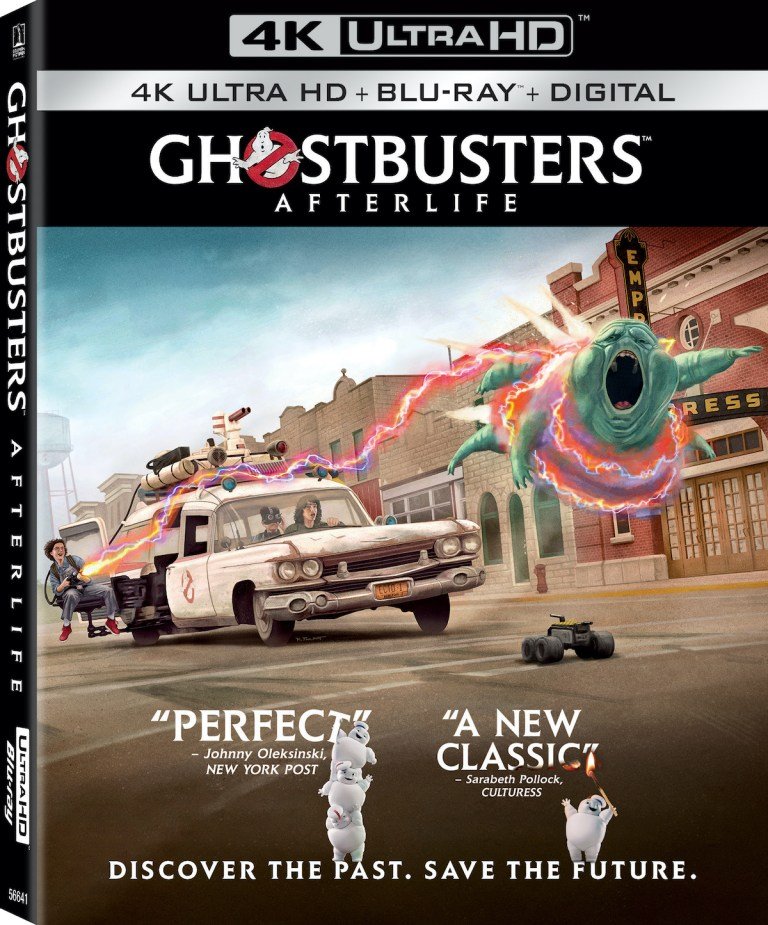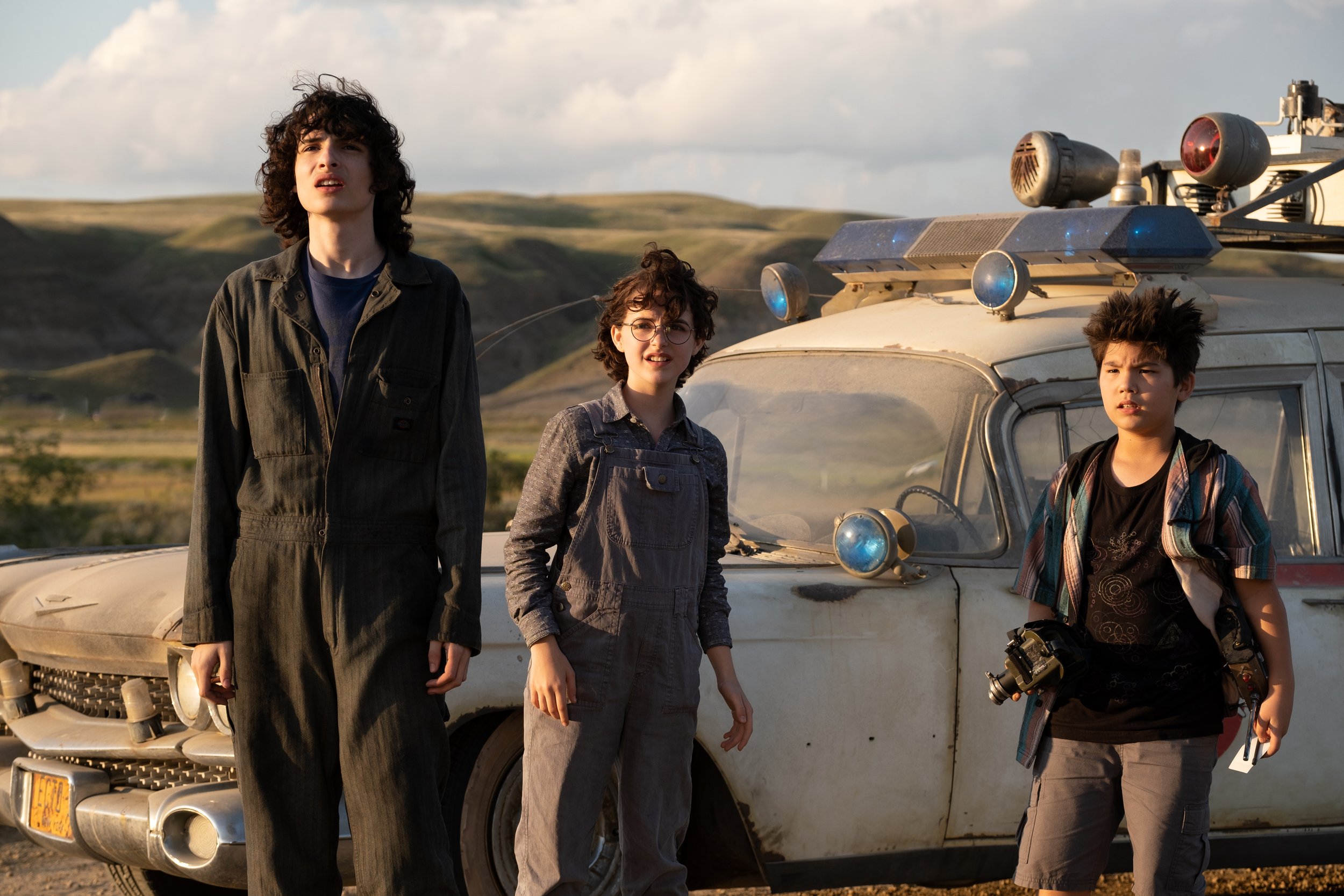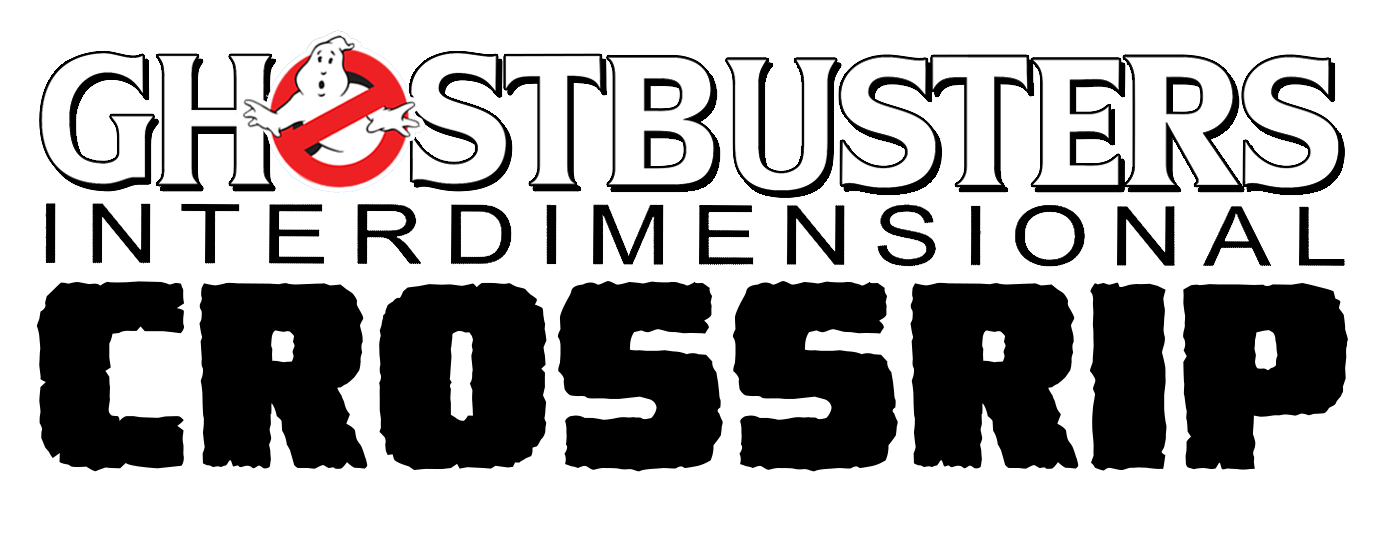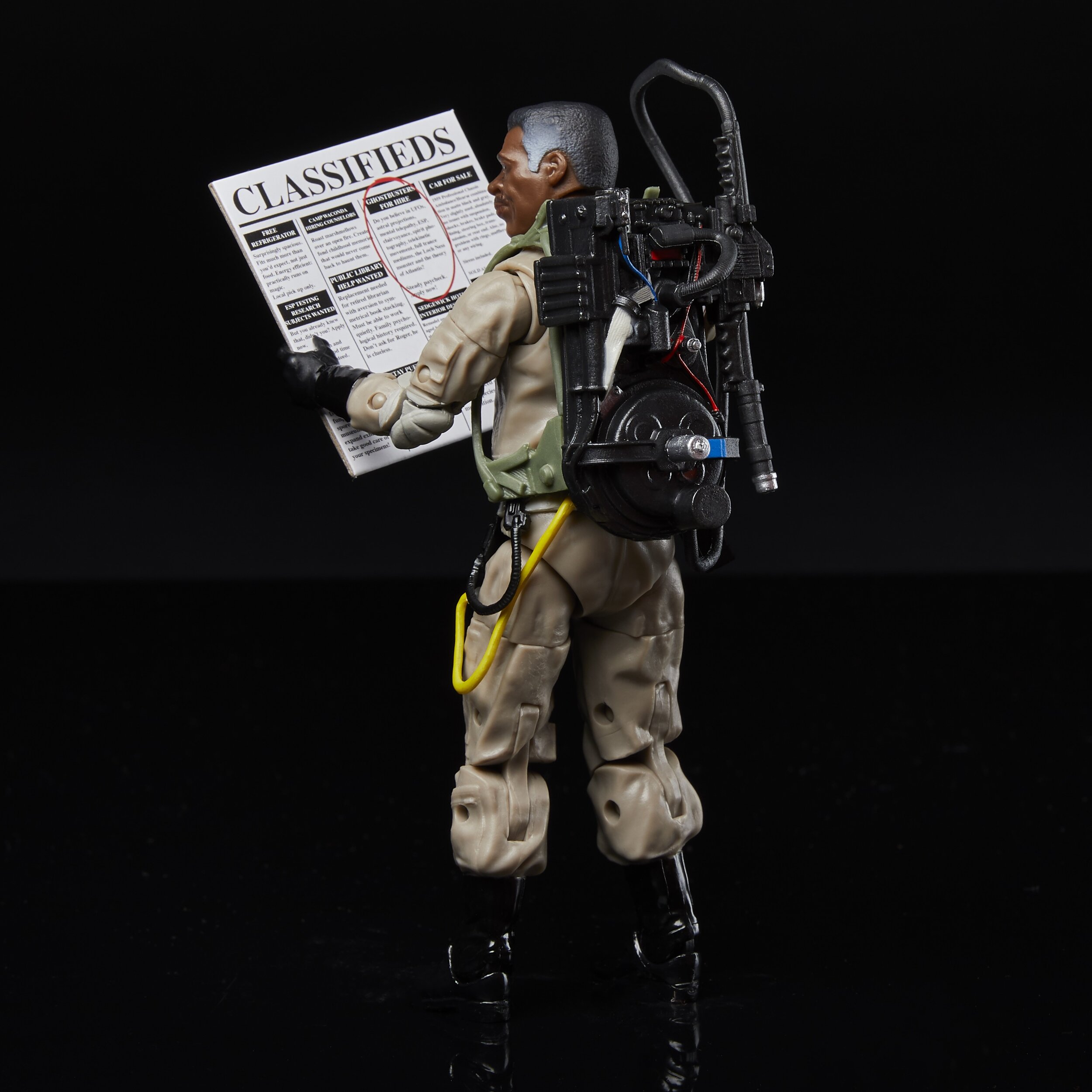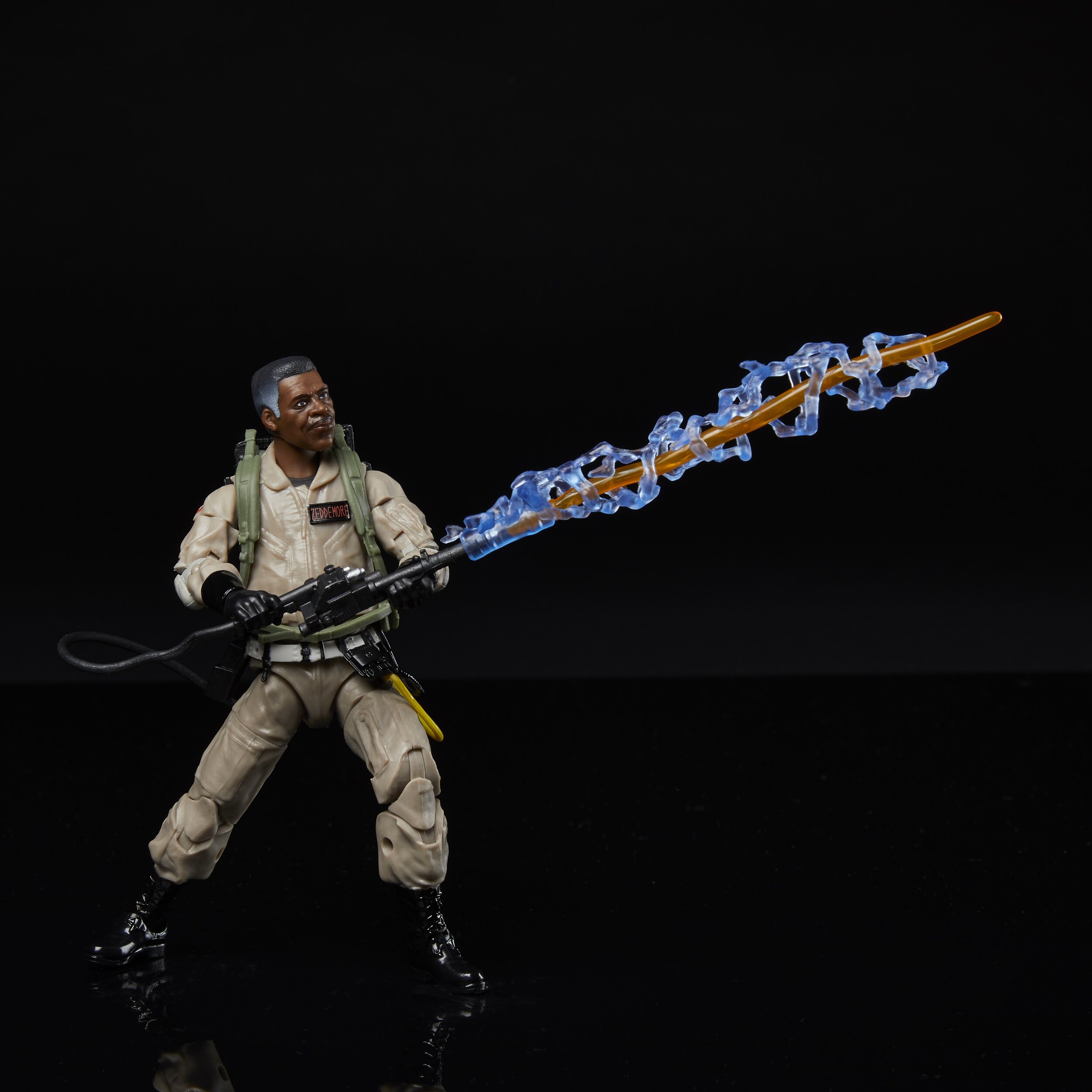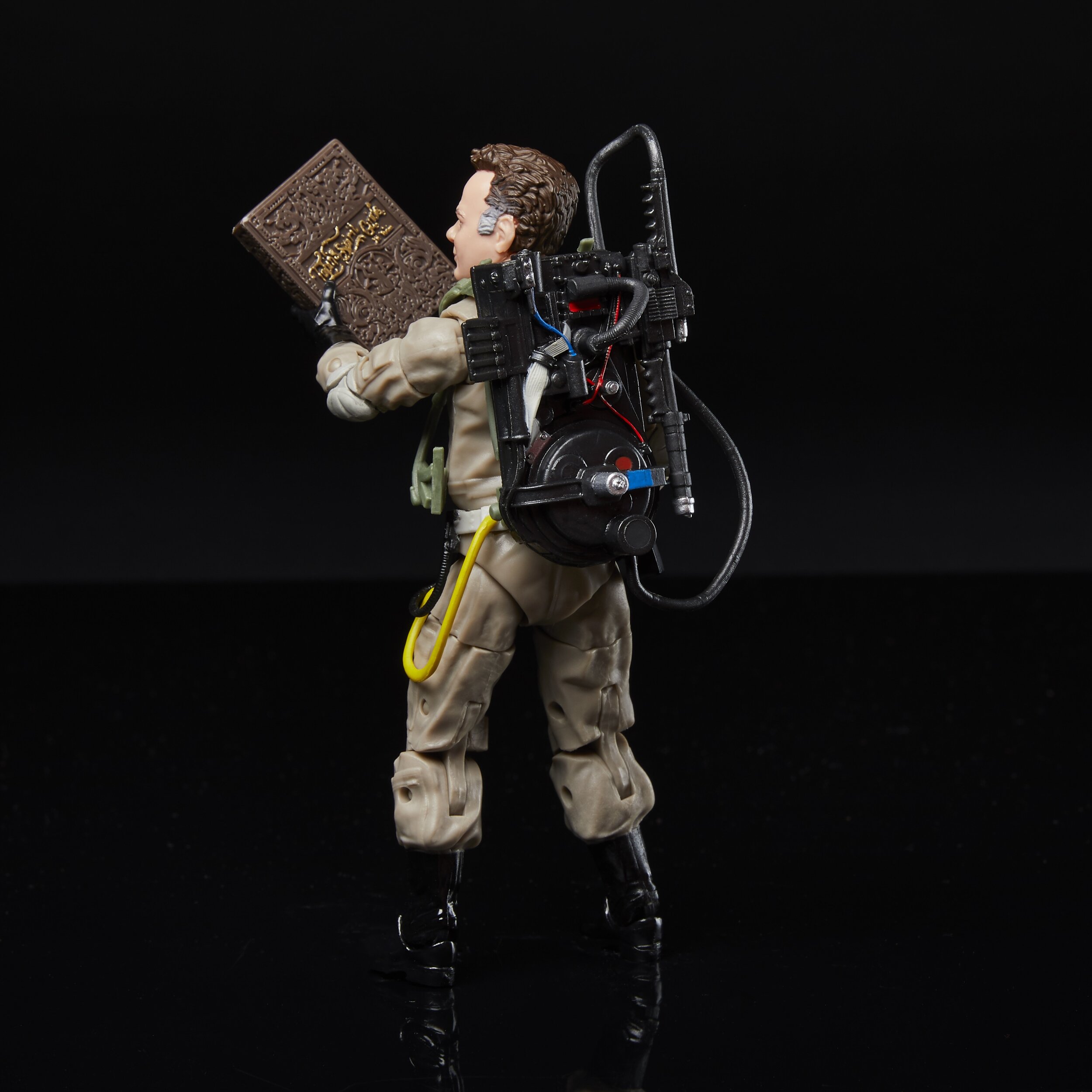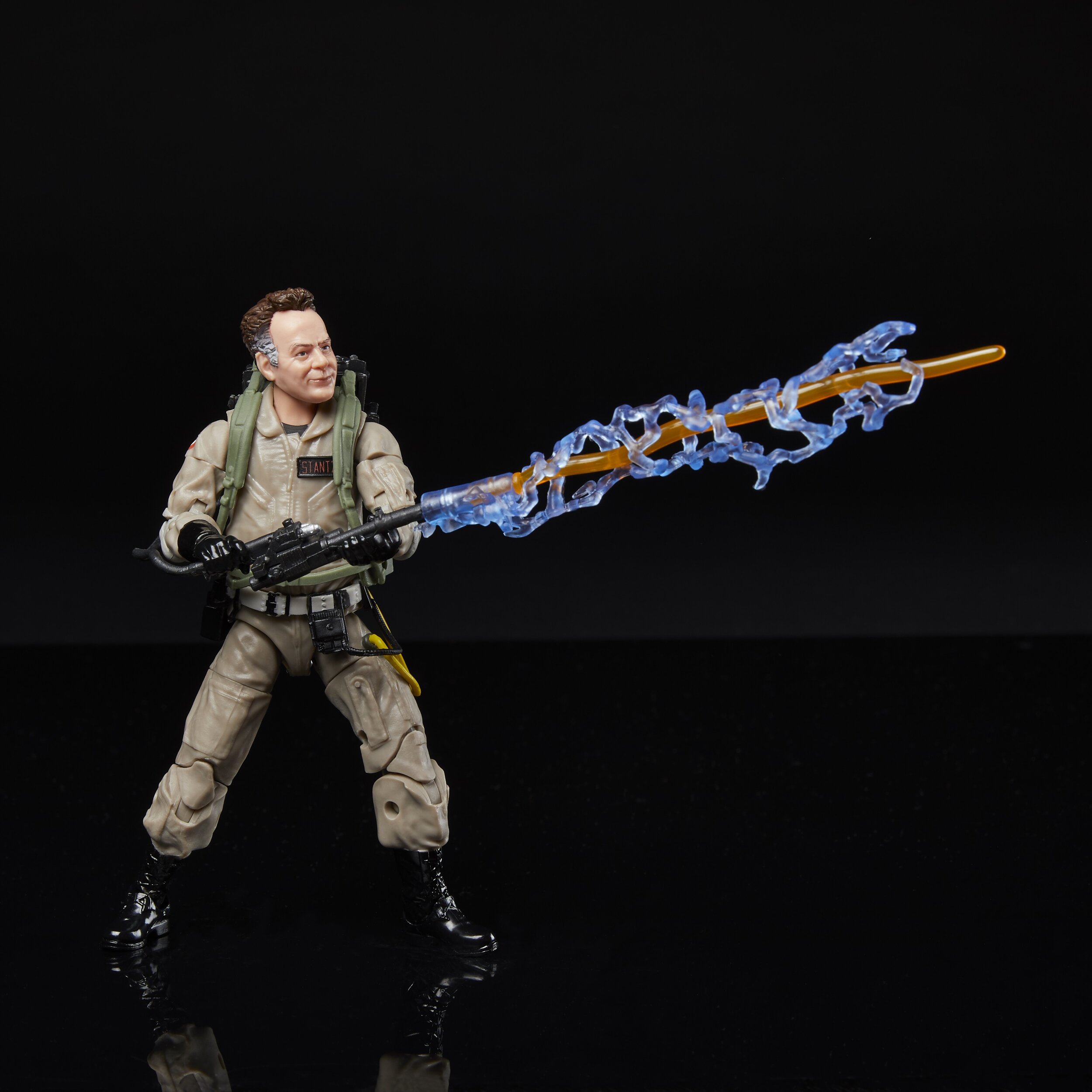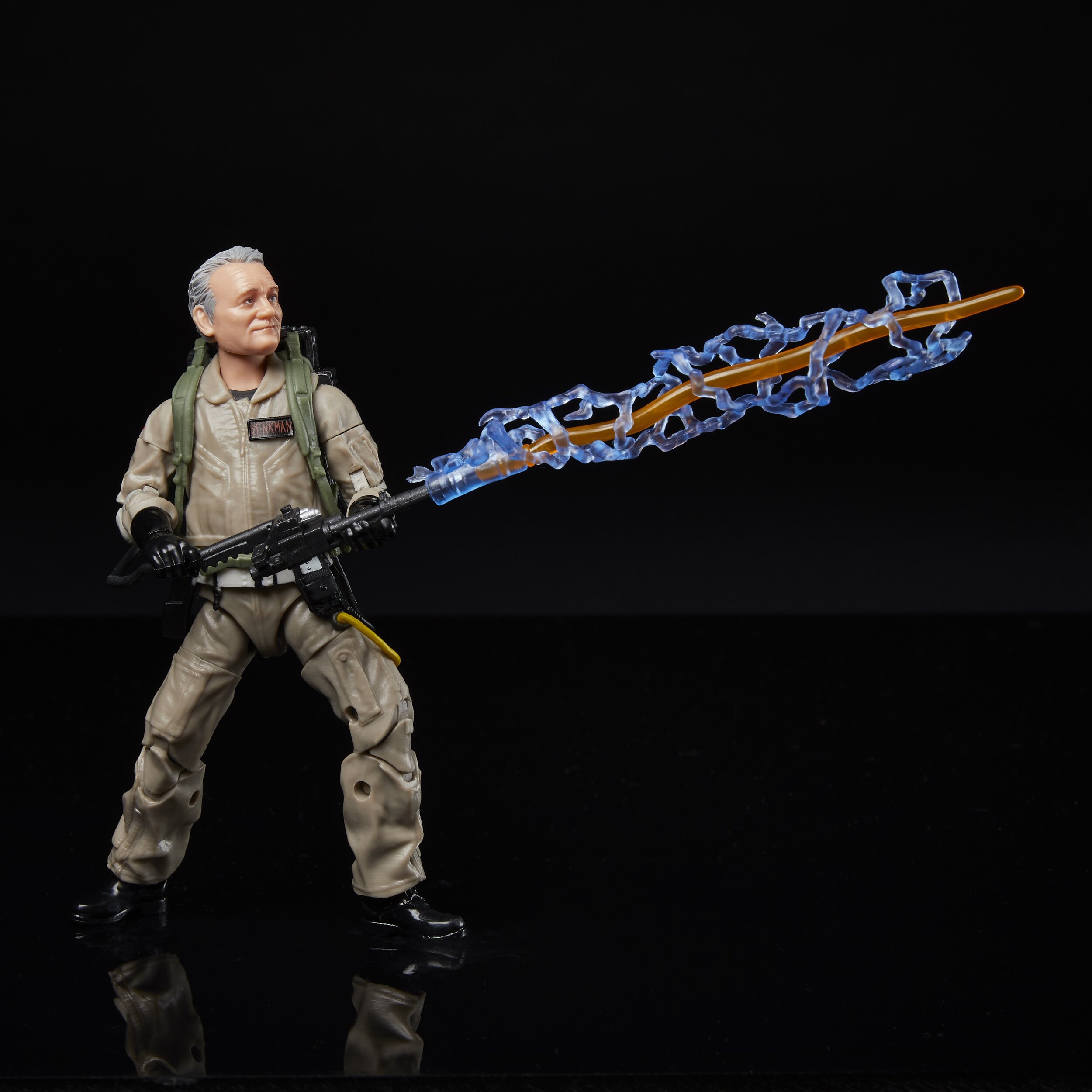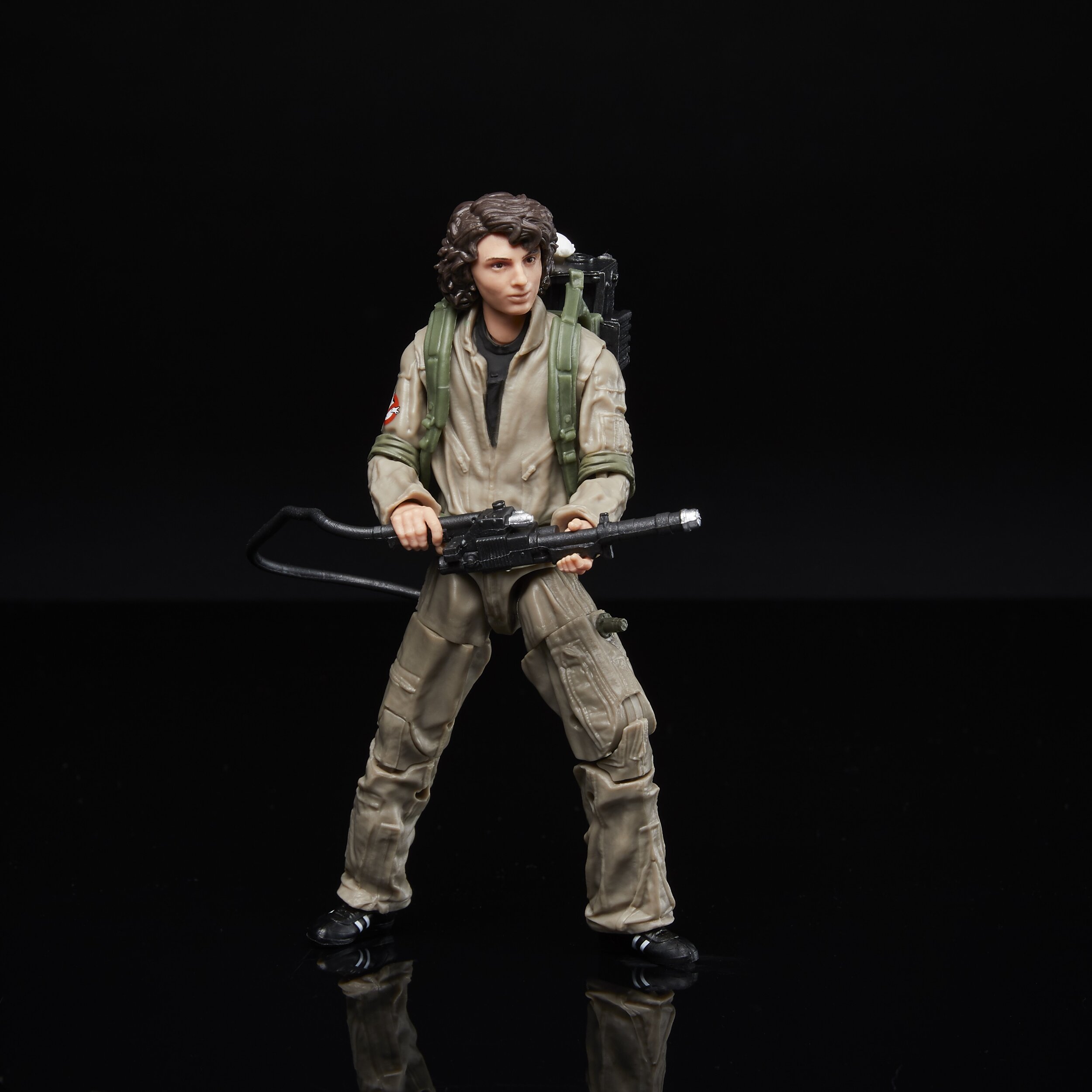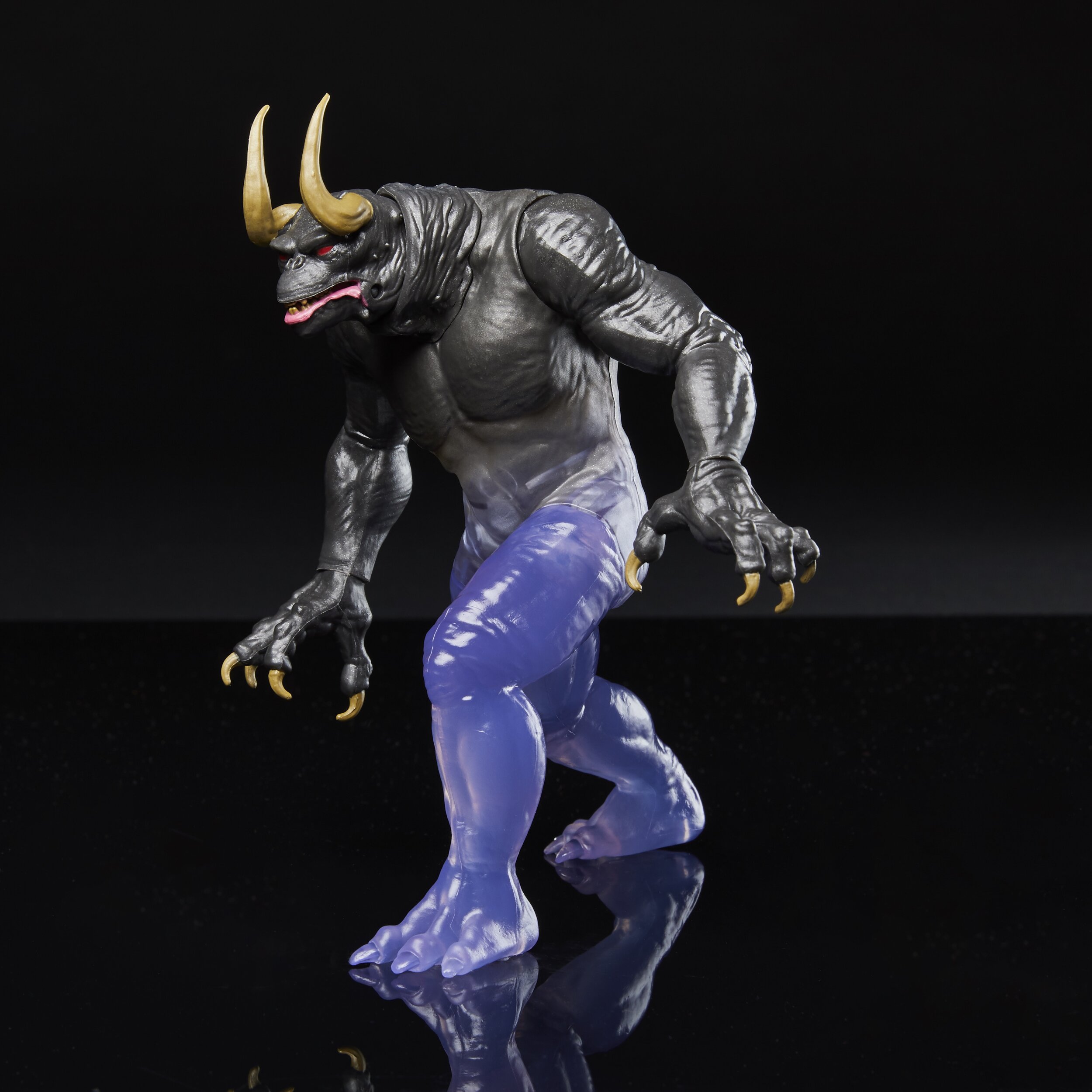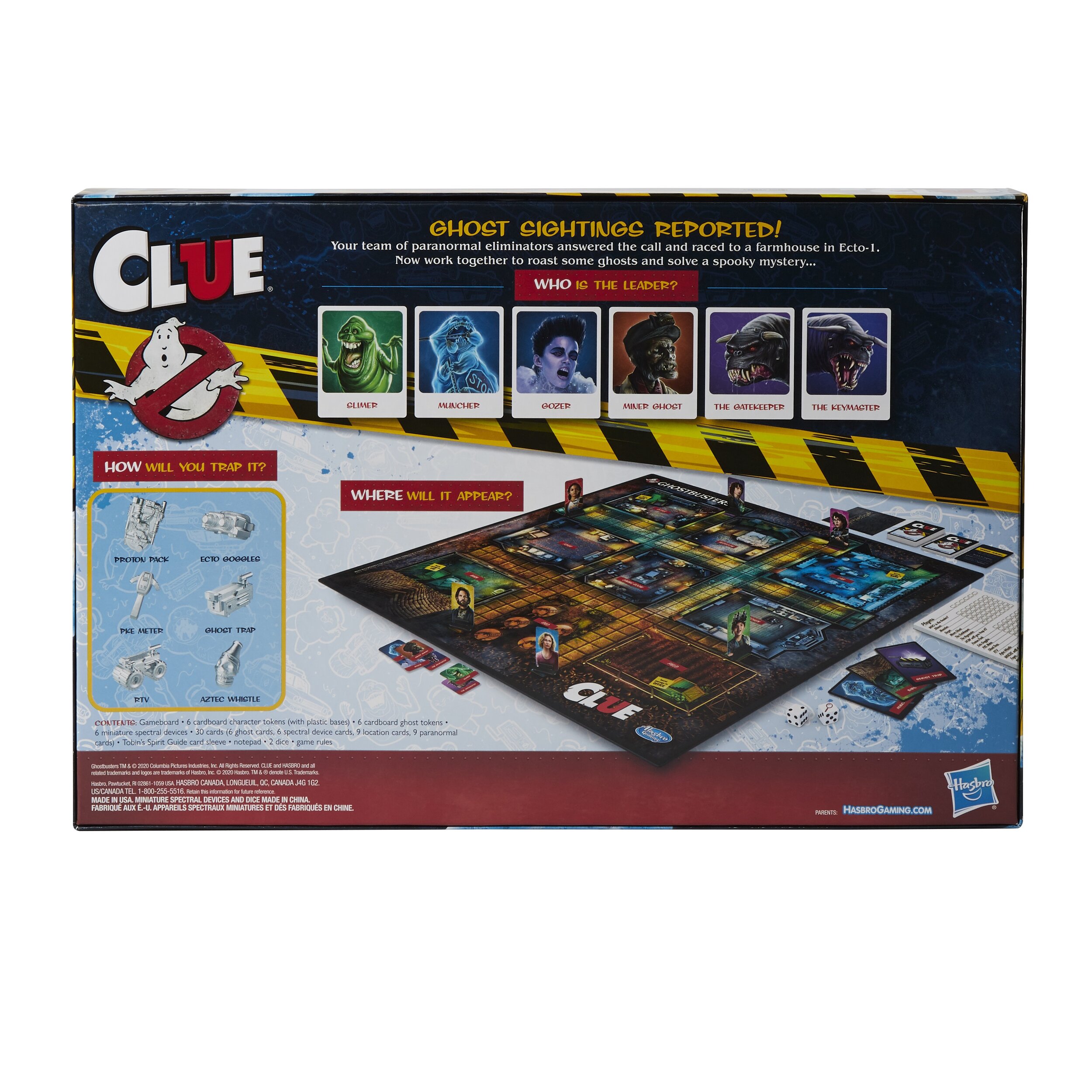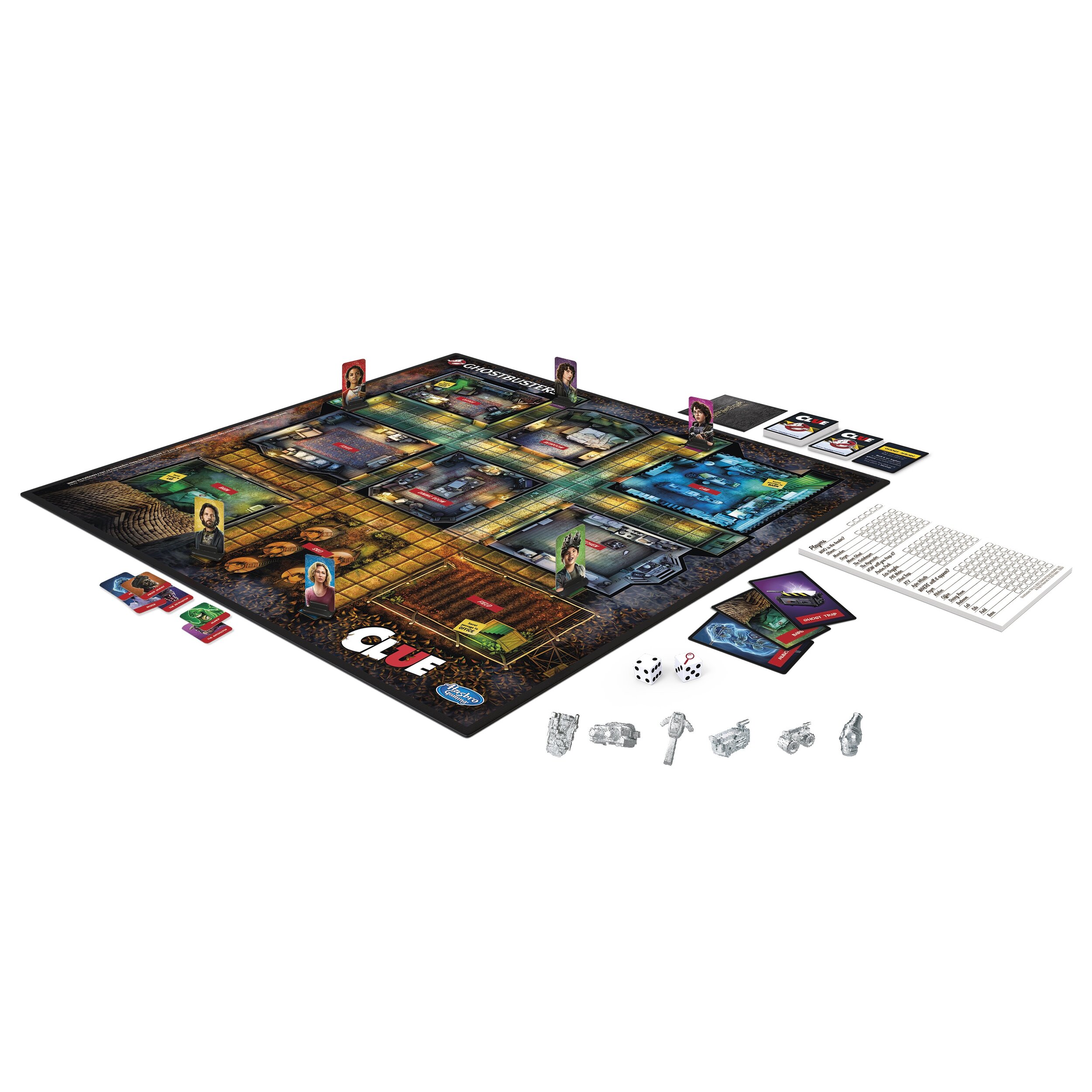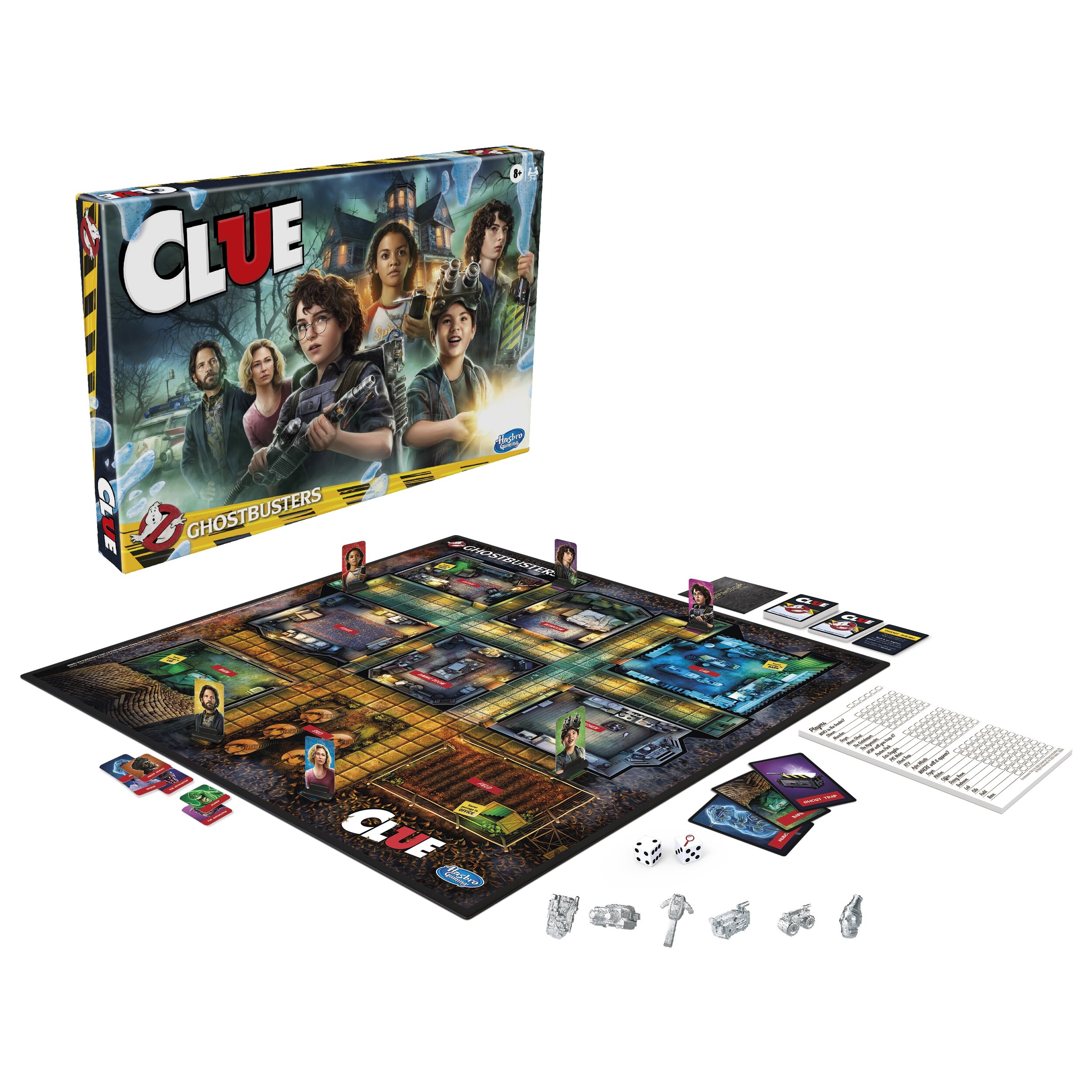An article that I had a whole lot of fun writing recently was an analysis of Randy Edelman’s Ghostbusters II album release. Not only did it afford me an opportunity to sit with the headphones and really concentrate on the music, but it really made me appreciate just how Edelman’s choices affected the film-going experience. And, particularly on that film, it was the first opportunity that I’d had to listen to the film’s score clean and uninterrupted. I thought, in celebration of Rob Simonsen’s fantastic score for Ghostbusters: Afterlife landing on LP, I’d do a similar deep dive on my observations track-by-track. Though the score has been on regular play rotation for me, particularly with the vinyl arriving from Music on Vinyl, it’s basically been on a loop for the last several days while I work and I’ve really started to notice all the tiny details throughout.
First and foremost, before I jump in, I believe it’s a mistake to dismiss the Afterlife score as simply derivative or completely duplicating Elmer Bernstein’s original 1984 compositions. A film journalist whom I respect and admire greatly told me that hearing echoes of identifiable music from the original film took her out of the experience and instead distracted her, evoking imagery and emotion from the 1984 film and not the story playing out in front of her on-screen. While I understand that, it’s also tough to hold musical familiarity against this score because it is so precisely trying to mimic the films of the 1980’s - heavily influenced by John Williams’ use of recurring motifs and accompanying character and situational themes. I don’t think it’s fair to make claims that Simonsen is “just copying Elmer Bernstein” because the true fact is that he’s paying homage to Bernstein’s themes, while also simultaneously nodding to the great maestros like John Williams, Alan Silvestri, Jerry Goldsmith, and more. It would be like saying Elmer Bernstein was “just copying” Bernard Herrmann because he utilized techniques and motifs from the Psycho score to punctuate Dana Barrett being attacked by an arm chair.
Both Simonsen and Director Jason Reitman latched onto themes in the original film that go hand-in-hand with feelings, movements, and tension in the same way that Yoda’s Theme and the Force theme accompany some of the greatest moments in Star Wars.
As with Edelman’s 1989 score for Ghostbusters II, Rob Simonsen has also introduced new themes and melodies of his own that are unique and special to Afterlife specifically. And, while instantly recognizable themes like the bouncy “Ghostbusters Hero Rag,” and ominous marching “Zuul Theme” are present and used to great effect, particularly on comedic moments between Phoebe and Podcast, there are also some wonderful new things in this score. There’s something that I call the “Mystery Theme” which weaves in and out of Phoebe’s discoveries at the Dirt Farmhouse (and even punctuates the final end tag scene of the Containment Unit in the credits). There’s a whimsical and energetic “Kids’ Theme.” The town of Summerville gets an upbeat and brassy, almost Old Western sounding theme. And then later on the album, Callie gets her own heroic theme that blows me away. More on that in a bit.
Sadly, with the LP release of the score, several cues have been omitted from the digital and CD release. I’ll be doing an analysis of everything released to date, but will note those that are absent on the vinyl album.
Just like the Ghostbusters II score analysis, I’ll continue updating this entry as I notice and decipher things. So make sure to check back for updates after a few more sittings down the road. Ready? Here we go.
Trapped
Much as Bernstein’s 1984 score hit audiences right from the Columbia logo with that great synth note, Simonsen plays off the Sony Pictures “Chime” on its logo to immediately play into a piano waggle that became Peter Venkman’s unofficial theme in the original 1984 film. The film score is tasked with a lot of heavy lifting as it acts as the audience’s first impression of the film. What are we in for? What will this film do tonally? Luckily, there’s some time and the score takes advantage of several production company and studio logos to act as an overture rise leading to the opening images of the Shandor Mine. Like descending into a cavernous room in a haunted house, the score really makes a meal out of the space at the head of the film. Afterlife does an incredible job doing exactly what the original film did, literally hitting a note of music that takes us into an odd world of the paranormal and really showcases the unique Ondes Martenot, recorded by Cynthia Millar in a special recording session in London. Millar being the original artist who played the Martenot on Elmer Bernstein’s score.
After the mood is adequately built over a lengthy minute or so, a bold and brassy and almost heroic refrain of the “Zuul Theme” pulls us out of the moody mist and into the action as Egon Spengler initiates his plan at the Shandor Mine. This is the first instance in which Simonsen has taken a familiar theme and adapted it into the film to serve a new purpose, this heroic three-note melody makes multiple appearances throughout the score - acting as a musical lift very similar to that of Alan SIlvestri’s incredible Back to the Future score (more on that later) would punctuate acts of heroism and defying the odds. Speaking of SIlvestri’s Back to the Future score, at about 1:25 of the track, Simonsen utilizes a very Silvestriesque transition into a ticking clock theme that’s very reminiscent of Back to the Future’s climatic clocktower sequence score. Though modern films rely on flashy non-linear music video style editing to help build suspense and tension and make moments feel as if they’re happening in a micro-second, it was a common trend in the 80’s to also implement a literal pulsing ticking clock score to subconsciously get audiences’ hearts beating in rhythm. This is a wonderful trick that Simonsen uses throughout Afterlife that adds to and enhances just how much Afterlife feels like a throwback to the classics.
A percussive and strong refrain of the Ghostbusters Hero Theme hits at about 1:35, another adaptation. These aren’t the same happy-go-lucky Ghostbusters we remember from the 80’s. They’re battle-tested. They’re heroes. They’re courageous. And this modification of the theme in this moment, accompanied by some stunt-driver worthy maneuvers by a silhouetted Egon Spengler really hammers this home. Though we don’t see his face, we know that’s a Ghostbuster behind the wheel thanks to this theme. And thanks to it intercutting with an ominous Zuul theme, the chase is afoot.
Spengler’s truck crashes and the music takes a soft moment to catch its breath. In the process, it introduces the low clarinet “Mystery Theme” as the Farmhouse is seen for the first time. The Mystery Theme is a short and curious melody that’s used quite a bit in the first two acts of the film. But before we’re really able to register it here, we’re back in the action as Spengler charges the lines of his neutrona field and readies to slam the pedal to entrap the entity chasing him. A long rise with some Mickey Moused footsteps on brass and piano grow louder and louder until the device fails and Egon is forced to scramble. A less confident Ghostbusters Hero Theme with some quick string plucks follow Egon as he improvises and grabs a PKE Meter and the fog builds around him.
A brassy rendition of the Mystery Theme transitions into a low fog horn-like mood shift that becomes a moment straight from the original film as Dana Barrett was taken from her apartment by Zuul and dragged across the floor in an arm chair. The same violent surprise Dana received is musically recreated here as Egon gets the same shock and is attacked from all sides.
A slow resolve after the attack musically helps the audience realize that Egon has passed, but his spirit remains in the Farmhouse while a soft and solemn rendition of the Ghostbusters Hero Theme concludes and resolves into the film’s title card. What a wonderful sequence cinematically and musically.
Dirt Farm
The film goes for a long stretch without score as the Spengler family is evicted, travels from Chicago to Oklahoma and arrives in Summerville. Simonsen’s work resumes as the family station wagon pulls up the unpaved driveway and past ominous and prophetic signs warning of the apocalypse to come. This track places the new Mystery Theme front and center stage as the family discovers the Farmhouse for the first time. High and rolling woodwinds provide a creepy fanfare with some strings and a very quick and very low brass refrain of the Ghostbusters Hero Theme. The mystery is overpowering and overshadowing everything here and the heroic Ghostbuster theme is literally buried underneath it, waiting to be discovered. Incredibly clever touches musically in the first minute or so of the track.
At about 1:30, the tone of the mystery shifts into a low almost bassoon noodle. This small phrase here is also used at the very end of the film to punctuate a very mysterious (and very dusty) Ecto-Containment Unit in the basement of the firehouse.
The track ends with a very lovely and almost romantic theme that longtime fans will recognize as that heard in the Sedgewick Hotel as the Ghostbusters split up looking for Slimer. I’ve come to call this the “Investigative Theme” as in the original film it accompanied the team tracking down an unknown entity, and here it accompanies the family picking at the strangeness of their estranged father/grandfather’s odd home. An optimistic rise of the Ghostbusters Hero Theme announces the presence of Janine Melnitz at the door as the track concludes.
Chess
Full and perfect bouncy Ghostbusters Hero Theme at the start of the track with an interjection of the familiar two-tone Martenot theme that accompanies strange and sometimes gross imagery on-screen (think when Venkman is asked to get a sample of Ectoplasm falling from the New York Public Library Card Catalog). As Phoebe is intrigued by the invitation for a game of chess and notices the PKE Meter chirp, the score also strikes a curious tone with a sweeping rendition of the Mystery Theme.
Summerville
Welcome to the frontier. The Summerville track has a bold and brassy introduction full of energy and of life. This track seems very inspired by Jerry Goldsmith’s themes for Kingston Falls in Gremlins with dashes of Elmer Bernstein’s most notable western scores like Magnificent Seven. In fact, when I first heard the track I couldn’t help but visualize a sweeping crane shot rising over a train station and revealing the bustling city center of Summerville. This energy and life makes the town feel big, even though it is deceptively small and sparse as result of a mine that’s long since closed up. It’s an optimistic and exciting track of music that plays wonderfully into Phoebe approaching summer school with promise of making new friends (out of what?).
It also provides a stark contrast to just how cataclysmic the music gets by the third act of the film. When Summerville is descending into a nightmare hellscape and the town’s residents are being overrun with ghosts. Keen ears will note this was something Elmer Bernstein carefully did with the original film score as well. By the third act, the score was big, bombastic, and felt like the heavy footfalls of the Stay Puft Marshmallow Man crashing its way through Columbus Circle. This bright and vibrant track helps balance out the creepy mystery of the farmhouse with some life, some energy, and a lot of light just waiting to be thrust into darkness.
Research (*not on LP)
They called it the Shandorian curse. As Podcast gives Phoebe a history lesson on the Shandor Mines and their dark history, a very ominous, almost solemn, cello leads into a quick refrain of the Zuul/Gozer theme along with what I’ve come to call the Cataclysm melody. This is a quick but foreboding six-note melody that is ever-present on Elmer Bernstein’s rooftop sequence from the original film and makes several memorable appearances here in Simonsen’s score as well. The Cataclysm theme is subdued, almost muted. The danger is there, lurking in the shadows. A great contrast to later in the film when this six-note theme thunderously booms accompanying a giant vortex swirling around the Spengler family farm. The track ends with a lovely segue into the mystery theme suggesting the mine and the farm are interconnected in some way that Phoebe has yet to realize.
Under The Floor (*not on LP)
The mysterious presence of ghosts is easily communicated in film language without special effects in Ghostbusters. All you need is a slight wisp of wind in the actors’ hair, and a little bit of Ondes Martenot. An etherial Mertenot solo suggests that Phoebe isn’t alone as an unseen figure leads her to a puzzle in the floorboards of the farm house - the mystery puzzle of course is noted with a brief refrain of the Mystery theme as Phoebe unlocks the secrets within. Listen closely in the far background at the mid-way point of the track for a low brassy interlude of the bouncy Ghostbusters Hero Theme that almost sounds like it’s buried under the floor of the house as well. The energy builds as Phoebe continues being led to a destination with a Mickey Moused screech as the armchair animates and jars Phoebe into position. The brassy Ghostbusters Hero Theme comes to the surface now and the warmth of the whole orchestra gives the audience a certain level of comfort that this unorthodox exchange between Phoebe and her unseen grandfather has led her to a stunning realization: a Ghost Trap within a puzzle box. The full warmth of the orchestra continues with a concluding rendition of the Hero Theme. The past is no longer buried.
Nice Replica (*not on LP)
A perfectly plucky piano solo of the secondary Ghostbusters Hero Theme with an infectious charm and youthfulness that perfectly encapsulates Paul Rudd’s performance of Gruberson seeing a “replica” of a Ghost Trap. Bernstein realized that this piano melody conveyed the Ghostbusters’ (particularly Peter’s) energy in the original film and this theme on the piano accompanied memorable moments like the “No Kiss” scene in Dana’s Apartment. This theme has always musically captured for me what makes Ghostbusters so charming: despite the snark, rough around the edges, cigarette dangling from the lips, destroying private property with a nuclear accelerator edge of the Ghostbusters the music betrays that they’re really just kids at heart. Try this as an experiment: listen to Nice Replica when you’re out for a walk or in an elevator and see what it does to your mood and how it makes you feel. If a stranger approached you on the walk or entered the elevator, and this melody accompanied the soundtrack to your life, how would it change your demeanor.
Culpable (*not on LP)
That building “walking” theme starts out the track with a quick piano refrain of what is often used as Venkman’s theme occurring at :10 into the track. As Gruberson and the kids rig the Ghost Trap to a school bus alternator for a little power and end up unleashing hell, a full bombastic orchestra version of the Zuul/Gozer theme accompanies. After a brief valley for us and the characters on-screen to recover from the scare, the Ghostbusters Hero Theme slowly builds as a tension release. Though the explosion of the trap scared the hell out of them and us, this experiment showed the equipment was real, it still functioned, and maybe they released something they weren’t supposed to in the process.
Laboratory (*not on LP)
The Mystery Theme is on full display in Laboratory. The twists and turns of the theme starting out the track front and center. Again the motif of a subdued and almost buried Ghostbusters Hero Theme played on a low brass punctuates Phoebe’s exploration of a secret laboratory hidden underneath the farmhouse. At around the :56 mark, a low and ominous refrain from the Zuul/Gozer theme both punctuates Egon’s ultimate plan and perhaps his demise. The Mystery Theme segues back into the spotlight and a warm, friendly almost resolving rendition of the Ghostbusters Hero Theme hits at the midway point as Phoebe discovers a rack of jumpsuits hanging in the closet (and a discarded Crunch bar wrapper to boot). Despite the ominous tones of the Zuul theme, Phoebe gets a chance to breathe as do we as on-screen we receive confirmation that her grandfather was Egon Spengler. The Mystery Theme continues with a bit more purpose as Egon shows Phoebe how to complete the prototype Proton Pack he’d been developing at the time of his death.
At about 2:38, something wonderful happens that rarely occurs throughout the score, this is the first instance of a synthesizer really playing in Afterlife as a distant almost echoing synth ticking clock can be heard for a brief moment leading into a highlight of Ondes Martenot. That synth/Martenot combination was a staple of the original 1984 score and plays so well here. The combination of technology and the unknown interplaying just as they do in the film itself.
Lab Partners
This track was among the first released and previewed before Ghostbusters: Afterlife was released in theaters and for good reason, it’s a fully focused and bouncy rendition of the Ghostbusters Hero Theme in all its glory, upright piano with the woodwinds and horns having a ball. From the perspective of the album experience, having this full heroic rendition of the main theme play shortly after Phoebe’s discovery is a wonderful segue in the the second and third acts of the film as portrayed here on the score release. But of note, this is the score cue that primarily accompanies Podcast walking Phoebe through Summervile and asking her to tell a joke. I’d be curious if bits of this track were sliced off and edited into that sequence but may have actually been written to accompany a deleted scene in which Phoebe tests out the new Proton Pack in a corn field and ends up creating the popcorn she’s eating while watching the OGB’s television commercial on her laptop.
Definitely Class Five (*Not on LP)
The first of three tracks that are dedicated to the Muncher chase, which is one of the biggest centerpieces of the Afterlife film. The track begins with a marching purposeful melody (which gets a reprise later in the film in one of my favorite sequences where the kids suit up as Ghostbusters and infiltrate the Summerville PD to retrieve the Ecto-1 and the Spengler Pack). At around the :37 mark, the track has another wonderful homage to the Alan Silvestri scores of the 1980’s: an almost militaristic “dun-dun” that sounds similar to a recurring bit Silvestri used in the Clocktower sequence of the original Back to the Future. Again, as mentioned earlier, it should be noted that Simonsen’s Ghostbusters: Afterlife score is as much of a love letter to the original Ghostbusters as it is to the most memorable scores from the 80’s. Keep that in mind when listening to these three tracks and how much you notice they evoke similar feelings to watching your favorite pop culture films from the era.
A sweeping and brassy rendition of the Ghostbusters Hero Theme plays to the nosebleeds at close to the minute mark a moment accompanying the Ecto-1 in a grand wide shot heading into town. The creep factor kicks into overdrive as the new Ghostbusters discover Muncher on a street corner and a stare-down ensues. The track immediately segues into:
Go Go Go (*Not on LP)
Oddly this is the track that I’ve had the most discussion with a couple colleagues who point to “musical moments I remember from the original movie taking me out of the film.” Because the start of this track is so front and center and really kicks off the chase sequence, it really gives the score a chance to shine but many including my colleague associate this specific piece of music with Louis Tully being pursued by a horrifying Vinz Clortho through Central Park. Admittedly, it’s tough not to hear this piece of music and hear Rick Moranis’ voice yelling, “Help, there’s a bear in my apartment!” — but I didn’t bump on this as much as others may have. After all a “chase sequence” in Ghostbusters this is. As was the moment in which a Terror Dog is bounding across the street after our favorite accountant.
However, I also have a feeling that this might be one of the few tracks that Jason Reitman and Rob Simonsen mentioned they returned to some of the original recordings for the 1984 film to capture some of those performances. Particularly around the :19 mark of this quick track, the strings either sound like the musicians in the new scoring session were spot-on with their performance and mic placement to replicate the 1984 recording, or in fact that might be the 1984 strings playing. So perhaps subconsciously, because this music is so familiar to our ear and brain, and because it’s engrained with a moment in time from the original film we associate the music with so clearly, our own brains are playing tricks on us.
Regardless of that, it’s tough not to hear this cue nor watch the film with this cue playing at full volume and not feeling as if it’s spot-on Ghostbusters. It’s hard to mistake that, no matter how many tricks our curious brains wish to play on us.
Trap Him
A rolling screech (literally accompanying the Ecto-1 tearing around a corner with Phoebe hanging out the side) leads to a rousing brass fanfare for the Ghostbusters Hero Theme moves us into the next phase of the Muncher chase sequence as the Ecto-1 closes in on the blue entity. The track segues into a march again, sounding very Alan Silvestri as the tension builds. At about the 1:12 mark, Simonsen does something interesting with the Zuul theme - giving us a quick refrain of it in a brassy major chord. Where the theme is usually utilized for ominous Mickey Mousing of evil afoot, here it’s used triumphantly. As if Zuul’s evil is about to be overcome as Phoebe shouts to Podcast to, “Trap him already!” Unfortunately, it doesn’t go as planned and Phoebe breaks her proton stream through the bed of a pickup truck and half of Spinners’ neon sign.
The film takes a quick breath here for a bit of diegetic music with Willie Nelson’s “On the Road Again” heard by the patrons of Spinners. But the album track keeps right on rolling picking up in the same spot as the tires of the Ecto screech to a sliding stop. A quiet and sweet flute solo gives us the Kids’ Theme as they collect themselves physically and mentally. Muncher heads to the mountain and the track really builds the suspense of will they/won’t they trap Muncher before a bridge closes in on them.
Great tension music comes to a crescendo that ultimately is punctuated with a reimagining of Elmer Bernstein’s “trap sequence” cue heard in the Ballroom of the Sedgewick Hotel that then exudes the musical equivalent of a jump for joy (which the RTV Trap demonstrates on-screen). A brief pause into resolve as the heroes celebrate their victory and are able to take a few deep breaths along with the audience. But at the 3:30 mark, the heroes realize Muncher was trying to escape to the mine and perhaps it’s a sign. A synthesized let down harkening back to a tension release as Dana Barrett floats four-feet above her covers takes the edge off the excitement and returns us to the real stakes in the film’s progression.
It’s with this that Rob Simonsen’s ode to lengthy 1980’s John Williams-era set-piece scoring comes to a conclusion. To me, this ranks right up there with the Star Wars assault on the Death Star in terms of the music really lending a hand to telling a beginning, middle and end of a sequence within the film.
Don’t Go Chasing Ghosts (*Not on LP)
A short piece of beautiful music that accompanies Phoebe realizing that she needs to use her one incarcerated phone call to dial the phone number in the old Ghostbusters advert, Simonsen does something incredible at about the one-minute mark of the track: he takes the bouncy Ghostbusters Hero Theme and turns it into a warm, nostalgic, even maybe a little tired and removed rendition of the theme. Ray Stantz has shielded himself, chosen to bury himself in his work at Ray’s Occult rather than relive the past. The score completely mirrors this while also warming the audience to seeing Aykroyd’s iconic character on-screen for the first time in thirty-plus years.
Ultimately the dialogue scene between Ray and Phoebe is so poetic and bittersweet, that we could hear a pin drop in between their dialogue and Simonsen’s score keeps it just as quiet. Choosing to help entwine their conversation with brief and emotional musical interludes.
Once again, this is a great track to point toward in demonstrating how Simonsen has not only adapted the original themes but is using them to great effect in conveying emotion and tone with perfection. I love it.
Mini-Pufts
The sliding and whimsical “Ectoplasm Theme” and a heavy dose of synthesizer kicks off this cue as an etherial entity makes its way past the Wal-Mart greeter and into the local Summerville department store. Gruberson spies something shake on the Wal-Mart shelf. A tension building music cue betrays the cuteness that arrives on-screen with the first Mini-Puft, who rubs the sleep out of its eyes and toddles toward Gruberson enthusiastically. A dreamy lullaby of synth accompanies the Mini-Puft awakening. The cue takes a hard turn, as does the adorable moment when Gruberson gets nipped on the finger and chaos ensues. Synth builds to a bouncing and chaotic cross between Looney Tunes Merry Melodies score and Jerry Goldsmith’s now iconic Gremlins rag. In fact, just before the two-minute mark of the cue, the synth plucks a couple chords extremely evocative of Goldsmith’s six-note Gremlins theme. Energy builds as the number of Mini-Pufts multiplies, as does the damage and destruction they cause.
A new Mini-Puft theme begins around 2:20. It’s a cute and mischievous melody that also continues to incorporate the two-note Ectoplasm Theme.
Watching the world burn comes to a jarring and complete stop as Gruberson turns a corner to find Vinz Clortho snacking on a giant bag of dog food fit for Cousin Eddie to throw in Clark’s cart. Gone is the cuteness and mischief as the chase is on and Gruberson bolts. As Gruberson runs for the doors and Vinz follows in hot pursuit, the Zuul Theme kicks into high gear.
It was an interesting, and perhaps deliberate decision not to utilize the same musical chase cue that followed Louis Tully’s pursuit in this moment (and was also used earlier in the film at the start of the Muncher chase sequence). I can only surmise that, since the events unfolding on-screen are so familiar and echo things of the past, that maybe dropping that cue here felt too on the nose. Regardless, the stark contrast between the Vinz/Gruberson chase and the whimsical Puft themes that start the cue make this a fun and interesting track. Keen ears will also remember this is the first bit of score that fans heard from the film, as it was used to score Jenn Fujikawa’s fun DIY videos that were created in promotion of the film.
Down the Well (*Not on LP)
Just as Elmer Bernstein’s original 1984 score gradually built from mysterious and bouncy to bombastic and catastrophic, the Afterlife score shifts after the Muncher bust. The stakes are higher and the music follows. As our heroes descend into the Shandor Mine, the score Mickey Mouses lowering into the darkness and utilizes the natural breathiness of the Ondes Martenot to build the mood. The Gozer/Zuul theme slowly creeps into the mystery around the two-minute mark as evidence of Shandor’s grand plot is uncovered. Phoebe puts the puzzle together, discovering that her grandfather Egon Spengler had been holding the line, literally guarding the portal to prevent another crossrip. As the PKE surges and builds, the music rises at about 3:25. This is another of the few times that Simonsen utilizes a fairly modern trope of a doppler cinematic rise sound effect built into the score. Rises and bass drops became so common in trailers that they eventually worked their way into the actual sound design of films, and this isn’t uncommon. But more on Simonsen’s use of rises in a bit.
The Temple Resurrected (*Not on LP)
A fairly short track, the past repeats itself as Gozer reenters our dimension. This track pays homage to the rooftop sequence of the original Ghostbusters as Gruberson diverts the proton streams from crossing and allows the portal to open fully. As a possessed Callie jumps out the window and flees into the farm outside, listen very closely in the last few seconds. There’s a wonderful little nod to the sweet and “release of tension” melody that plays right after Dana Barrett floats four feet above her covers.
The Plan (*Not on LP)
Aside from the Muncher chase, “The Plan” is where Simonsen ventures the most into Alan Silvestri homage. Phoebe grabs a PKE Meter and heads outside, realizing that the entire farm has been constructed as a giant trap. She leads the team down the firepole and into the subterranean Spengler lab. As she does, Simonsen gives us a driving and purposeful version of the Kids’ theme along with some Silvestri (dare I say some Morricone) trademark whip cracks and a thumping bass line from a piano. It’s a lot of fun as the strings and percussion all hit in a syncopated, driving beat while Phoebe shows the team the model of the farmhouse. Yes, while Ghostbusters: Afterlife is evocative of the original Ghostbusters films, here it’s paying very loving tribute to Back to the Future and Doc Brown’s “not quite to scale” model of Clocktower Square. From about 2:10 to 2:30, the score on the album here deviates from the film a bit just before we see Callie and Gruberson unite “formally” at what appears to be Summerville’s version of the famous Vasquez Rocks from Star Trek. There are a few pick-up reshoots in this sequence (as evident by Phoebe and Podcast looking slightly older in a few shots), so it stands to reason there was some music editorial in the final version of the film necessary to work with the recut sequence.
Suit Up
Our heroes break into the Summerville police department to reclaim their ghost-catching gear and the driving Silvestri score continues. About twenty seconds into the track, Simonsen musically begins to marry the Kids theme and the Ghostbusters Hero theme. Listen closely as the energetic theme that’s accompanied the kids gets a couple quick stings of the Hero melody, first as a high toned refrain, then again with some brass and power, each time building in confidence. While Phoebe, Podcast, Trevor, and Lucky have all donned the flightsuits and are working to free the Ecto-1, they’re also musically acquiring the Ghostbusters’ hero theme. It’s a lovely build that of course crescendos with a throw back to the Ecto-1’s original firehouse reveal and the blaring of a familiar siren in the sound effects.
As the Ecto-1 speeds toward the Shandor Mine, we now get a quick, urgent, brassy, energetic and fully-merged version of the Ghostbusters Hero and Kids theme at 1:52 before an ominous and foreboding tone ends the track.
No, I’m Twelve
A dimensional gateway has opened and Gozer is here, ready to rule our mortal plane. The music gets big and operatic, but not before an eerie intro in this track with punctuated flute notes and a refrain harkening back to the very first mysterious piece of score we heard in 1984’s Ghostbusters as Alice the librarian walks through the stacks. New Vinz and New Zuul walk toward the temple steps. Interestingly, Simonsen opts to not use the four-note radio serial sounding “bum bum dum dummm!” The music explodes as the two raise their hands to the sky and other worldly lightning strikes them, opening the portal for Gozer while simultaneously turning the possessed humans into their Terror Dog form. The orchestra swells, the synth wails. Our new Ghostbusting heroes, who have been waiting in the shadows make their move.
Getaway
The climax of the film officially begins and Simonsen’s score does quite a bit of heavy lifting, bouncing between the sentimentality of the family story resolution and the climatic battle with Gozer. The track begins with a quiet moment. The new heroes’ plan is enacted as the gatekeeper is trapped by the RTV, Callie is loaded into the Ecto-1, and the game is afoot. A ticking clock chase ensues with a heroic and brassy rendition of the Ghostbusters Hero theme at a minute and a half dovetailing into the Mystery Theme as Callie is brought up to speed. The mystery is solved and this version of the theme has energy and strikes a major chord. But with Keymaster Vinz hot on their trail, a bouncy Terror Dog stomp breaks the mood and brings us back into the action. Simonsen is able to work in a quick refrain of the Kids’ theme at the end of the track for good measure, effectively giving us a wonderful overture of all the major themes of the score in one bite.
Callie (*Not on LP)
When I first picked up the album, I initially thought this might be a tangent in the action - possibly a concert version of Callie’s theme. Interestingly, this track is a bit out of chronological order in the album presentation. A sweet a melodic track that accompanies Callie venturing down into her father’s lab and realizing that in fact, he had been keeping track of her throughout the years.
Here’s why I think this track is presented here leading into the end of the film: at about 1:35 into the track a new melody is introduced. It’s a warm, tender, and very strings heavy motif that plays a huge part in the closing moments of the film. It’s just slightly off from the Mystery theme, almost a resolute version of it. As if the mystery is no longer veiled in shadow and out in the open. Let’s call this Callie’s Theme from here-on out. And it gets a wonderful spotlight just before a mist creeps into the underground room and possesses our hero.
Protecting the Farm
The Ecto-1 once again does an impression of the Griswold Family Truckster launching back to the Spengler Farm. Zuul’s crossrip theme is in full effect here at the top of the track before a soft moment of mystery. You can almost hear the trademark Ivan Reitman “gust of wind” in the breath the music takes before going into nearly five minutes non-stop.
Because this track is wall-to-wall, it also incorporates lots and lots of those trailer sounding rises. The score is subliminally putting us on edge, and assisting the sound design a few times here. Once at :53 for almost a full minute, then again later at 2:13, and 3:04, and a few teasing instances thereafter. If I had one critique of the score, it would be the overuse of the rises here to help accentuate the rising tension and the powering up of the farm’s “trap.” Amid such a beautiful homage to the thematic scores of the past, it’s such an overused modern trope. It certainly works, especially when mixed into the final soundstage of the film, but for me is one of the only things that bumps when I listen to the score on its own.
That aside, the record scratch on the operatic hits at 3:39 when three figures emerge from the distance to help save the day. As we hear familiar voices and see familiar faces of Venkman, Stantz, and Zeddemore a heroes fanfare gives way to a plucky and whimsical rendition of the Ghostbusters Hero Theme. Perfect for the ad-libbed Venkman dialogue it accompanies. But then it’s back down to business as the action resumes at 4:24 with purpose and intensity.
Showdown
A shot is fired to garner Gozer’s attention: it’s from young Phoebe with a determined look on her face. Phoebe digs in (literally and figuratively) and interestingly Callie’s Theme, introduced just a short while ago on the album, swells. Perhaps attributing some of Callie’s theme to her daughter here for a heroic moment. Despite her courage and strength, Phoebe seems outmatched and wavers. The music takes a breath.
At :41 the twist: after taking a brief respite, a lullaby rendition of the Ghostbusters Hero Theme. A tender and paternal musical moment as we see on-screen, a translucent hand cover and reenforce Phoebe’s…
…a full John Williams swell of the Ghostbusters Hero Theme as we’ve never heard it before signals the return of Dr. Egon Spengler, there to assist his granddaughter. The score continues with strength, pausing only for a moment for friends to reunite in the strangest of ways at 1:30. The trap is spring at 1:40 and the villainous Gozer is defeated with a triumphant flourish at the end of the track.
Reconciliation
And so, we come to the final track of the album. Which just happens to be my favorite as well. It’s an emotionally-charged track that tugs on the heartstrings for a variety of reasons. Not just because we’re seeing a character on-screen for the first time but also because our protagonists are also getting closure and a moment to say goodbye. A few highlights in this track:
:40 - as a warm, strings heavy rendition of the Ghostbusters Hero Theme swells, a piccolo quickly punctuates the Mystery Theme. The two are entwined now. The mystery is over.
2:05 - a perfect rendition of the Ghostbusters Hero Theme for a marshmallow fluff covered Podcast to meet his hero Ray Stantz. The plucky version of the theme is childlike and youthful and fits the two of these characters and their enthusiasm so well. And it seamlessly blends into:
2:45 - Callie’s Theme, with as much emotion and poignancy possible, which plays over Egon seeing his grandkids face to face and a wonderful and tender moment of a grandfather tucking a strand of hair behind Phoebe’s ear.
3:30 - A violin solo with a melody that is unique to this moment and this moment alone. Egon and Callie embrace in a hug as Trevor puts an arm over his sister's shoulder. Zeddemore, Stantz, and Venkman all watch with tears welling in their eyes. This sweeping orchestration immediately calls to mind John Williams’ “Saying Goodbye” from E.T. because of the lift that, combined with incredible performances, it provides for the film.
That lump in your throat that both the E.T. track and this new score from Simonsen produce is honestly what movies are all about. Being along on a ride with characters, empathizing with them to literally feel the emotion they feel. And the greatest film scores are such an intrinsic part of that emotional experience. Yes, we don’t necessarily equate a movie like Ghostbusters with sentiment and emotion, but the most memorable films from the 80’s all left lasting impressions and this is a love letter not just to the 1984 classic, but so many of the films responsible for our pop culture to date. It’s an emotional bookend to our childhoods. Just as the Spengler family has experienced a resolve and a new purpose, so too has this franchise and the films and stories that will continue. This is an emotional closure to chapter one. And a herald for a new chapter to begin.
At 3:55, the orchestra plays the Ghostbusters Hero Theme to the walls. The day is saved. A spirit can rest and cross over to the other side. And a definitive orchestral hit brings the score to an end.
What a treat this music is from start to finish.
